Contents
Chesapeake Clean Water Blueprint Clean Air Act Challenges Clean Water Act Challenges Clean Water Act Permit Challenges Forest Conservation Hazardous Waste Hydropower Land Use and Zoning Cases Maryland Critical Area Cases Maryland Habitat and Natural Resources Cases Natural Gas PipelinesThe Chesapeake Clean Water Blueprint
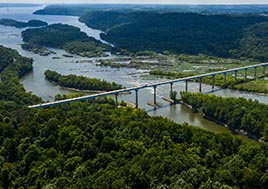
John Pavoncello/York Dispatch
Chesapeake Bay Foundation, et. al. v. United States Environmental Protection Agency, et. al.
United States District Court for the District of Columbia
Case No.: 1:20-cv-02529 (and consolidated case)
In December 2010, EPA used its authority under the federal Clean Water Act to issue a Total Maximum Daily Load for the Chesapeake Bay and its tributaries (Bay TMDL) to limit excess nitrogen, phosphorous, and sediment pollution from the entire Chesapeake Bay watershed.
The Bay TMDL required each jurisdiction (DC, DE, MD, NY, PA, VA, and WV) to issue Watershed Implementation Plans (WIP’s) in three phases—2010, 2012, and 2019. WIP’s include detailed, specific steps each jurisdiction must take to meet the Bay TMDL by 2025. The combination of the TMDL and WIPs serves as the Chesapeake Bay Clean Water Blueprint (“Blueprint”). It was agreed that EPA would oversee TMDL progress and take action(s) necessary to ensure that the Bay States adhered to the terms of the Chesapeake Bay Agreement.
In the past, CBF has been successful in litigation to support Bay restoration and the Blueprint. CBF’s lawsuit against EPA in 2009 resulted in a settlement agreement that set specific deadlines for development and completion of the Bay TMDL. Fowler et al. v. EPA (2010). CBF defended the Blueprint from attacks by the American Farm Bureau and its allies. In that case, a federal court judge in Pennsylvania found that the Blueprint created through a federal/state partnership was legal and an example of “cooperative federalism.” This decision was upheld by the Third Circuit Court of Appeals in American Farm Bureau v. EPA (2015). A request to have that decision reviewed by the United States Supreme Court was denied. See Litigation’s concluded cases for additional details.
In 2019, Pennsylvania and New York submitted Phase III WIP’s that failed to clearly identify how each state would attain levels of pollution reduction required by the Bay TMDL by 2025. EPA approved these WIP’s without significant change, ensuring that Bay water quality will not be restored by 2025. As a result, in September 2020, CBF and our partners filed suit against EPA in the U.S. District Court for the District of Columbia for failing to comply with its responsibilities under the Clean Water Act, the 2014 Chesapeake Bay Agreement, other laws, and the Blueprint. We sought to have a court direct EPA to require Pennsylvania and New York to revise their respective WIPs so that on their face the WIPs meet each state’s TMDL obligations by 2025. Our partners in the Litigation were Anne Arundel County, Maryland; The Maryland Watermen’s Association; and Robert Whitescarver and Jeanne Hoffman, CBF members and operators of a livestock farm in Virginia.
Our case was consolidated with a separate, but similar lawsuit filed by Attorney General in Maryland, Virginia, Delaware, and the District of Columbia. EPA filed a Motion to Dismiss the cases in November 2020. Plaintiffs’ deadline to respond to the Motion to Dismiss was extended several times to allow EPA to certify the administrative record and to allow the parties to continue settlement negotiations. Also, New York intervened as a defendant in the consolidated cases but was subsequently dismissed when it voluntarily amended its WIP in May 2021.
Over the course of time the case was pending, the parties participated in settlement discussions and on April 20, 2023, CBF and our partners reached an agreement with EPA to implement a plan for EPA to meet its commitment to reduce pollution under the Blueprint. The proposed settlement was published in the Federal Register for public comment. As part of the settlement, EPA will look for ways to reduce the Commonwealth’s biggest polluting sources- agriculture and stormwater runoff from urban and suburban land. EPA will also prioritize its efforts in the counties that contribute the most pollution to local rivers and streams. Those are Lancaster, York, Bedford, Cumberland, Centre, Franklin, and Lebanon counties. EPA also commits to increase compliance and enforcement efforts to ensure permits are up to date and reduce the administratively extended permits. The settlement is a win for clean water in the Chesapeake Bay because EPA will focus on concentrated remedial actions to address some of the severe problems in Pennsylvania while providing reasonable assurance that progress under the Blueprint will be met.
After the 30-day public comment period expired, the settlement was finalized, and the parties filed a Stipulation of Dismissal with the United States District Court on July 12, 2023.
CBF issued a Press Release on April 20, 2023, announcing the Settlement Agreement and a Press Release on July 12, 2023 announcing the case has been dismissed.
CBF and our partners continue to monitor EPA’s actions in accordance with the agreement to ensure EPA’s commitments are met. EPA has published a website where actions will be posted detailing the progress being made. We review all the documents and reports EPA delivers as part of its commitments.
CBF was represented in this matter by the former Vice President of Litigation Jon Mueller and the current Vice President Paul Smail.
Supreme Court of the United States
American Farm Bureau Federation et al v. EPA
Supreme Court Case No.: 15-599
Updated: 4/20/2016
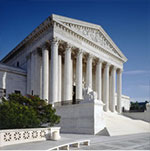
U.S. Supreme Court
On December 29, 2010, EPA used its authority under the federal Clean Water Act to issue a Total Maximum Daily Load (TMDL) to limit excess nitrogen, phosphorous, and sediment pollution from the entire Chesapeake Bay watershed. This action followed more than 25 years of failed voluntary agreements, litigation, congressional actions, executive branch actions, and cooperative technical work, including a May 2010 settlement agreement of CBF's lawsuit against EPA that set specific deadlines and several other conditions for the TMDL.
Less than two weeks after the Bay TMDL was finalized, the American Farm Bureau Federation and the Pennsylvania Farm Bureau together filed a complaint in federal court against EPA in an effort to stop the TMDL and the implementation plans from moving forward. The lawsuit challenged several key aspects of the Bay TMDL - EPA's authority to issue the TMDL, the science and information used to develop the pollution limits, and the public participation process. The two initiating groups were eventually joined by several other agricultural trade associations as well as the National Association of Home Builders.
In 2011, CBF along with Citizens for Pennsylvania's Future, Defenders of Wildlife, Jefferson County Public Service District (WV), Midshore Riverkeeper Conservancy, and the National Wildlife Federation filed a joint motion to intervene in this case in support of EPA and the Bay TMDL. Several municipal wastewater groups also asked to intervene in support of EPA and the Bay TMDL.
After briefing and oral argument, on September 13, 2013, Pennsylvania Federal Judge Sylvia Rambo issued a ruling upholding EPA's authority to issue the Bay TMDL and rejecting the arguments of the Farm Bureau, the National Association of Home Builders, and other big agricultural interests. See the District Court's Opinion.
The American Farm Bureau Federation and its partners appealed the ruling to the Third Circuit. Attorneys general from 21 states (all but one outside the Bay watershed) and eight counties within the watershed filed amicus curiae (friend of the court) briefs supporting the American Farm Bureau Federation and its allies in the effort to derail Bay cleanup.
CBF fought back, rallying support for the Blueprint through government leaders, environmental organizations, and concerned citizens nationwide. As a result, in April of 2014, amici briefs in support of EPA and upholding Judge Rambo's decision were filed by the states of Virginia, Maryland, Delaware, and the District of Columbia; seven cities including San Francisco, Baltimore, New York, Philadelphia, Los Angeles; a group of 19 prominent law professors; and 27 environmental organizations from across the country.
On November 18, 2014, oral arguments were held in the United States Court of Appeals for the Third Circuit located in Philadelphia, Pennsylvania. The panel of three judges closely examined the Farm Bureau's arguments and indicated concern for harm to crabs, fish and oysters by Bay pollution.
In a historic victory for the Chesapeake Bay Clean Water Blueprint on July 6, 2015, in a unanimous decision, the Third Circuit affirmed the ruling issued by the District Judge Sylvia Rambo upholding EPA's TMDL pollution allocations for the Chesapeake Bay. See Third Circuit Court decision. According to the Court, "[e]stablishing a comprehensive, watershed-wide TMDL-complete with allocations among different kinds of sources, a timetable, and a reasonable assurance that it will actually be implemented is reasonable and reflects a legitimate policy choice by the agency in administering a less-then clear statute."
The American Farm Bureau Federation and its partners petitioned the United States Supreme Court to overturn the Third Circuit's ruling by filing a Petition for Writ of Certiorari on November 6, 2015. Again, the agricultural and home builder groups solicited scores of states and politicians from outside the Bay region to file amicus briefs in support of their petition. CBF and its partners filed a Brief in Opposition with the Supreme Court requesting that the petition be denied. EPA also filed a brief in opposition. On February 29, 2016, the Supreme Court denied petitioners Writ of Certiorari allowing the Third Circuit's decision and the Chesapeake Bay TMDL to stand.
This matter was handled by CBF's former Vice President for Litigation Jon Mueller and counsel for the Southern Environmental Law Center.
MORE INFORMATION ABOUT THE CHESAPEAKE BAY CLEAN WATER BLUEPRINT
Chesapeake 2000 Agreement Lawsuit
United States District Court for the District of Columbia
C. Bernard Fowler et al. v. EPA et al.
Updated: 5/10/2010
In January 2009, CBF, along with several signatories to the Chesapeake Bay Agreements, a fishing association, and two watermen's associations, filed a complaint in the U.S. District Court for the District of Columbia against the U.S. Environmental Protection Agency (EPA) for failure to comply with the Clean Water Act and the terms of the Chesapeake Bay Agreements. Settlement discussions began with the new Administration soon after the suit was filed.
Significantly, on May 12, 2009, President Obama issued an Executive Order (EO) instructing six federal agencies including the EPA Administrator to exercise leadership and develop a federal strategy to restore the Bay by the following May. With the EO as a backdrop, CBF agreed to stay the litigation and continue negotiations. Municipal stormwater and wastewater treatment groups intervened to oppose our suit, but were not required to participate in the negotiations.
After 15 months of negotiation, the Plaintiffs and EPA reached an agreement and a settlement was finalized on May 10, 2010. The historic settlement agreement provides a legally binding, enforceable commitment that EPA will take specific actions to ensure that pollution to rivers, streams, and the Chesapeake Bay is reduced sufficiently to remove the Bay from the federal "impaired waters" list. EPA agreed that it would develop a Bay Total Maximum Daily Load (TMDL) by December 31, 2010. The TMDL was established on December 29, 2010.
The agreement is comprehensive and includes accountability and consequences for failure. The agreement specifically incorporates the TMDL process and requires that state implementation plans meet specific criteria. Importantly, the agreement states that EPA will consider a suite of consequences should the states fail to act or meet their milestones. Unlike the TMDL or EO, under this agreement CBF can go back to court if the federal government fails to comply with any of the terms of the agreement. (This expired in 2017)
This matter was handled by CBF's former Vice President for Litigation Jon Mueller.
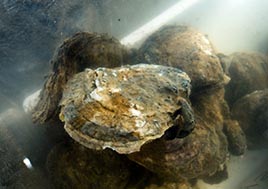
Donnie Biggs
Virginia—Phase III Watershed Implementation Plan
Hanover Circuit Court
Virginia Association of Municipal Wastewater Associations v. Virginia Department of Environmental Quality
Case No.: 19003147
Updated: 3/4/2022
In August 2019, Virginia proposed its third Watershed Implementation Plan (WIP) setting forth how the Commonwealth plans to meet the nutrient (nitrogen and phosphorus) and sediment allocations established for Virginia’s portion of the Bay in EPA’s Chesapeake Bay Total Maximum Daily Load (Bay TMDL). However, the Virginia Association of Municipal Wastewater Associations (VAMWA) filed suit challenging Virginia’s WIP. In their appeal, they ask the court to find the entire WIP invalid and strike the provision requiring wastewater treatment plants to upgrade their facilities. CBF filed a Motion to Intervene in this case on January 10th as VAMWA’s challenge threatens the Commonwealth of Virginia’s ability to meet the Blueprint goals by 2025. DEQ filed a Motion to Dismiss the appeal. This matter was dismissed without prejudice in April 2021. CBF continues to monitor the Commonwealth’s plans to meet its obligations in the Phase III WIP.
This case was handled by CBF's former Vice President for Litigation Jon Mueller along with staff counsel in the Virginia office.
Clean Air Act Challenges
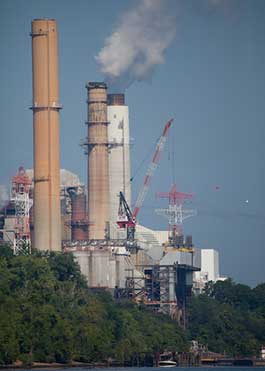
Krista Schlyer/iLCP
Mercury Pollution
Updated: 9/1/2023
Since 2005, CBF has successfully pushed EPA to require stringent controls on coal-fired power plants to reduce airborne hazardous pollutants, including mercury. In collaboration with other public interest groups, CBF’s legal actions led to the creation of a federal regulation known as the Mercury and Air Toxics Standards (MATS), 77 Fed. Reg. 9304 (Feb. 16, 2012). Unfortunately, it was again threatened in 2020.
MATS was based on EPA’s finding that it is “appropriate and necessary,” under the Clean Air Act, to regulate mercury and toxic air emissions from fossil fuel-fired power plants that pose a significant hazard to the environment and to human health. The mercury from power plants falls from the air into rivers, lakes, streams, and the Bay where it is taken up by plants and small organisms and gradually travels up the food chain into fish and other wildlife. The mercury is converted into methylmercury, a neurotoxin that attacks the human nervous system and causes IQ deficits in children. This toxin can eventually be ingested by people who consume contaminated fish and can cause serious adverse health effects. Mercury contamination is especially damaging for developing fetuses and young children. Low-income communities, communities of color, and subsistence fishers who rely on self-caught fish to feed their families, are also at greater risk.
Despite the dangers caused by exposure to mercury pollution, the MATS have been repeatedly challenged in court by industry groups and some states. While those actions were initially defeated in the lower courts, the challengers asked the U.S. Supreme Court to overturn those decisions and vacate the MATS in 2013. CBF joined in the filing of a brief opposing the challengers' petition for certiorari. The petition was granted, and the U.S. Supreme Court in Michigan v. EPA, found that EPA had unreasonably failed to consider costs when conducting its “appropriate and necessary” finding.
In response to the Supreme Court’s ruling, EPA completed an economic analysis and in April 2016 issued a Supplemental Finding that the costs of the MATS Rule were reasonable, and the standards remained “appropriate and necessary.” This finding was immediately challenged in court by Murray Energy, a coal mining company. CBF joined a coalition of NGOs to intervene and defend the Supplemental Finding. In April 2017, with the case fully briefed and scheduled for oral arguments, the government moved to hold the case in abeyance while it reconsidered its position supporting the Supplemental Finding; the Court granted EPA’s request and suspended the case.
In April 2020, EPA issued a final rule attempting to reverse the 2016 Supplemental Finding. The 2020 rule changed how EPA considered the costs and benefits of the MATS Rule and determined that regulating hazardous air emissions from coal-and oil-fired power plants is not "appropriate and necessary," even though studies show that as fully implemented, the MATS Rule led to a 96-percent reduction in emissions of mercury and other hazardous air pollutants at significantly less cost than industry had anticipated. During the public participation process, CBF submitted a comment letter on how EPA's proposal to undermine MATS could lead to increased mercury emissions within the Chesapeake Bay airshed and how reducing mercury pollution is crucial for Bay restoration and protecting the region’s communities.
In June 2020, CBF joined a coalition of public interest groups challenging the 2020 rule at the U.S. Court of Appeals for the D.C. Circuit. CBF’s case was consolidated with other appeals filed by industry groups and a coalition of states, including Bay watershed states. The case is docketed as Westmoreland Mining Holdings v. EPA (Case No.: 20-1160). On February 17, 2021, the Court issued an Order holding the cases in abeyance pending EPA’s implementation of Executive order 13990 directing EPA to review the MATS Supplemental Finding. On February 8, 2022, EPA issued a proposed rule to revoke the 2020 finding that stated it is not appropriate and necessary to regulate coal- and oil-fired electric utility generating units under the CAA. CBF joined public health and environmental organizations and submitted comments supporting EPA’s proposal.
On March 6, 2023, EPA finalized a new rule in the Federal Register superseding the 2020 rulemaking and reinstated the “appropriate and necessary” finding. No challenges to the new rule were filed, and the parties voluntarily dismissed the consolidated cases on July 5, 2023.
CBF was represented in these matters by counsel for Earthjustice, CBF Litigation Staff Attorney Ariel Solaski, and former Vice President for Litigation Jon Mueller.
Actions to Reduce Greenhouse Gas Emissions Under the Clean Air Act
United States Court of Appeals for the District of Columbia Circuit
Chesapeake Bay Foundation, Inc. v. National Highway Traffic Safety Administration
Case No.: 21-1091
Updated: 3/31/2022
On November 8, 2019, after NHTSA and EPA issued the final SAFE Part One Rule, CBF filed an administration petition for reconsideration requesting that NHTSA reconsider and withdraw its action in the SAFE Part One Rule. CBF’s Petition identified procedural and substantive flaws with NHTSA’s Part One Rule. On January 19, 2021, the evening before the presidential inauguration, NHTSA denied our administrative Petition. On March 18, 2021, CBF filed a petition for review with the D.C. Circuit to preserve the right to challenge the denial. This case was dismissed voluntarily on March 31, 2022.
These cases are being handled by CBF Litigation Staff Attorney Ariel Solaski.
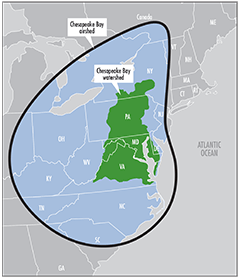
CBF
OZONE AND GOOD NEIGHBOR OBLIGATIONS
United States Court of Appeals for the District of Columbia Circuit
State of New York, et. al. v. United States Environmental Protection Agency
Case No.: 19-1020
Updated: 11/15/2019
Nitrogen oxide air pollution transported from upwind states combines with emissions from local sources and produces ground-level ozone, or "smog." Breathing ozone can cause respiratory illness and even early death for those at risk, including people with asthma, children, older adults, and people who spend time outdoors.
In 2016, EPA issued the Cross-State Air Pollution Rule (CSAPR) Update, for the 2008 ozone air quality standard, which partially address interstate pollution that significantly contributes to ground-level ozone in neighboring, downwind states. The 2016 CSAPR Update did not fully eliminate the upwind emissions. Then in 2018, EPA issued the "Bad Neighbor Rule," or CSAPR Close-Out, proposing that no further work was required to meet the 2018 standards.
To compel EPA to address interstate ozone pollution, CBF and our partners, Downwinders at Risk, Appalachian Mountain Club, and Sierra Club, filed a Petition for Review with the D.C. Circuit in January 2019. Our case was consolidated with similar appeals filed by downwind states, including Maryland, Delaware, and New York. After briefing was completed, and prior to oral arguments, the Court issued a Final Judgement on October 1, 2019 vacating the Bad Neighbor Rule for failing to eliminate interstate emissions contributing to downwind air pollution within the statutory deadlines required by the Clean Air Act. The Court's decision relied on a September 2019 ruling in Wisconsin v. EPA, Nos. 16-1406, et. al. (D.C. Cir. Sept. 13, 2019), that struck down part of the CSAPR Update for the same reason.
The Close-Out Rule did not protect human health or the environment, so now in accordance with the Court's decision, EPA must modify the Rule so upwind emissions will not contribute to violations of air quality downwind beyond the statutory deadlines. CBF will continue to monitor EPA's actions related to interstate transport of nitrogen oxide pollution and take appropriate action, if necessary.
This case is being handled by litigation staff attorney Ariel Solaski and counsel for partner environmental groups.
Actions to Reduce Nitrogen Pollution Under the Clean Air Act

EPA
Maryland and Delaware Clean Air Act Section 126 Petitions
United States Court of Appeals for the District of Columbia Circuit
State of Maryland, et. al. v. United States Environmental Protection Agency, et. al.
Case No.: 18-1285
Updated: 4/15/2020
Maryland suffers from high concentrations of ground level ozone, or smog, largely due to the pollution emitted from coal-fired power plants (electric generating units) located in upwind states. The Clean Air Act (CAA) includes a "Good Neighbor Provision" requiring each state to ensure that its air pollution will not interfere with the air quality standards in downwind or neighboring states. The State of Maryland submitted a petition to EPA requesting that EPA make a formal finding that the air pollution from 36 power plant units in Indiana, Kentucky, Ohio, Pennsylvania, and West Virginia are emitting air pollutants in violation of the Good Neighbor Provision and are significantly contributing to downwind States inability to meet the federal ground level ozone standard thereby creating a human health hazard. The State of Delaware submitted similar additional petitions to EPA.
EPA published a Notice in the Federal Register on October 5, 2018, denying the petitions. As a result, CBF and our partners, Adirondack Council, Chesapeake Climate Action Network, Clean Air Council, Environmental Defense Fund, Environmental Integrity Project, Physicians for Social Responsibility and Sierra Club appealed this decision by filing a Petition for Judicial Review with the D.C. Circuit Court of Appeals on October 19, 2018. CBF's case was consolidated with appeals filed by Maryland and Delaware. Utility Industry Groups have filed Motions to Intervene on behalf of Defendant EPA while the States of New Jersey and New York and the City of New York have intervened on behalf of Petitioners.
Oral arguments were held on January 16, 2019 and on May 19, 2019, the D.C. Circuit issued an opinion, requiring EPA to look more closely at pollution reductions for certain coal-fired units listed in Maryland’s petition and reiterating downwind states’ ability to obtain timely relief from out-of-state pollution. The Court deferred to EPA on other aspects of its petition denials. We will continue to support efforts to reduce interstate pollution for the health of the Bay and all of its residents.
This case is being handled by Litigation Staff Attorney Ariel Solaski, former Vice President for Litigation Jon Mueller, along with partner environmental groups.
Maryland 126 Petition Deadline Suit
United States District Court for the District of Maryland
State of Maryland, et. al. v. United States Environmental Protection Agency, et. al.
Case No.: 1:17-cv-02873-JKB
Updated: 5/1/19
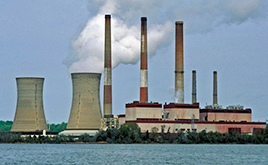
Chalk Point Generating Station
Adrian Jones
Maryland suffers from high concentrations of ground level ozone or smog largely due to the pollution emitted from coal fired power plants (electric generating units) located in upwind states. Despite several meetings between Maryland and those states, none would to take action to curb their pollution. The Clean Air Act (CAA) includes a "Good Neighbor Provision" requiring each state to ensure that its air pollution will not interfere with the air quality standards in downwind or neighboring states. If a state does not comply, a downwind state can file a petition under Section 126 of the Act with US Environmental Protection Agency (EPA) asking it to step in.
On November 16, 2016, the State of Maryland submitted a Petition to the Administrator of the federal Environmental Protection Agency. The Petition requested that EPA make a formal finding that the air pollution from 36 power plant units in Indiana, Kentucky, Ohio, Pennsylvania and West Virginia are emitting air pollutants in violation of the provisions of the CAA and are significantly contributing to Maryland's inability to meet the federal ground level ozone standard thereby creating a human health hazard.
The CAA includes a "Good Neighbor Provision" requiring each state to ensure that its air pollution will not interfere with the air quality standards in downwind or neighboring states. Under the CAA, the EPA is required to hold a public hearing and respond to Maryland's petition within 60 days. EPA did not respond to Maryland's petition nor did it hold a public hearing.
As a result, on July 20, 2017, Maryland and the Chesapeake Bay Foundation ("CBF") filed separate notices with EPA, pursuant to 42 U.S.C § 7604(b), of their intentions to file a citizen suit against the EPA and the Administrator of the EPA for failure to perform a nondiscretionary duty as mandated by Section 126 of the CAA.
EPA failed to respond to Maryland and CBF's notices. On September 27th, Maryland filed a Complaint for Injunctive Relief with the United States District Court for the District of Maryland against the EPA and its Administrator, Scott Pruitt. CBF and our partners, Adirondack Council, Chesapeake Climate Action Network, Environmental Defense Fund, Environmental Integrity Project, Physicians for Social Responsibility, Chesapeake, Inc. and Sierra Club filed a similar Complaint on October 4th. CBF's case was consolidated with the state's case.
On December 19th, Plaintiffs filed a Joint Motion for Summary Judgment based on the fact that the Defendants failed to take action after receiving Maryland's petition pursuant to section 126 of the Clean Air Act, and therefore the Plaintiffs are entitled to judgment as a matter of law. Plaintiffs also requested the Court to order the Defendants to act on Maryland's Petition by either granting or denying the petition within sixty days. The United States filed an opposition to Plaintiff's Motion and a Cross Motion on Remedy requesting until December 31, 2018 to issue a final agency action on the State's petition. On June 13, 2018, the Court granted Plaintiff's Motion for Summary Judgement and Ordered the EPA to take final agency action by September 15th.
In the interim, the EPA published a notice in the Federal Register on June 8, 2018 proposing to deny the petitions submitted by the state of Maryland and four petitions submitted by the state of Delaware. CBF attended the public hearing held on June 22nd and submitted comments by the July 23rd deadline. As anticipated, EPA published a Notice of Final Action in the Federal Register on October 5, 2018 denying the Petitions. As a result, CBF and our partners appealed this decision to the United States Court of Appeals for the D.C. Circuit. See active case summary details for State of Maryland, et. al. v. Environmental Protection Agency Case No.: 18-1285.
This case was being handled by CBF's former Vice President for Litigation Jon Mueller along with litigation staff attorney Ariel Solaski.
Glider Rule
United States Court of Appeals for the District of Columbia Circuit
Environmental Defense Fund, et. al. v. United States Environmental Protection Agency
Case No.: 18-1190
Updated: 8/1/18

Dennis Carr, Attribution 2.0 Generic (CC BY 2.0)
A "glider" is a heavy-duty diesel freight truck that combines a brand-new truck body (a "glider" kit) with a rebuilt engine and transmission. While they function similarly as new trucks, gliders emit more air pollution because they do not incorporate pollution controls that new trucks are required to have. One of the pollutants these trucks emit is oxides of Nitrogen (NOx) which is deposited on land and water making it a Chesapeake Bay pollutant.
In 2016, EPA, the Department of Transportation and the National Highway Traffic Safety Administration issued a final Rule restricting the number of glider trucks that could be built each year with the number decreasing each year. Glider trucks built in excess of the cap would be classified as new trucks and subject to the pollution control requirements of the Clean Air Act (CAA). EPA estimated in 2016 that 10,000 glider trucks are constructed per year and glider vehicles on the road in 2025 would emit nearly 300,000 tons of NOx annually without the 2016 Rule restrictions.
In 2017, EPA proposed a new rule that would essentially gut the 2016 glider rule claiming that the engines were not new under the CAA, and therefore EPA did not have authority to regulate the glider truck industry. CBF filed comments in opposition as the failure to implement the 2016 rule would add additional nitrogen loads to the Chesapeake Bay watershed.
On July 6, 2018, in his last day in office, former EPA Administrator Scott Pruitt took an unprecedented and illegal action and issued a memorandum providing assurance to the glider tuck industry that it would not enforce the terms of the 2016 Rule without going through the proper judicial review procedures. As a result, on July 17th, Environmental Defense Fund (EDF), Center for Biological Diversity and Sierra Club filed an emergency motion with the D.C. Circuit Court of Appeals asking the court to issue an emergency order halting the effectiveness of EPA's "No Action Assurance" and declare it illegal and void. The court granted the request for an emergency stay. CBF filed a Motion to Intervene in this proceeding on July 25th. Thereafter, Acting EPA Administrator, Andrew Wheeler, revoked the "no action assurance" and EPA asked the Court to dismiss the appeal.
This case was being handled by CBF's former Vice-President for Litigation, Jon Mueller and litigation staff attorney Brittany Wright.
Challenges to EPA Mercury Rules (Delisting Rule and CAMR)
U.S. Court of Appeals for the D.C. Circuit
State of New Jersey et al. v. EPA
5/1/2015
In 2000, the U.S. Environmental Protection Agency (EPA) determined that mercury emissions from coal-fired power plants should be controlled to the maximum extent possible and began to develop standards to regulate these emissions. However, after the change in administration in the fall of 2000, EPA reversed its decision without following the Clean Air Act requirements for making such a reversal. EPA also passed regulations that allowed utilities to trade the right to pollute. Given that mercury is a heavy metal that falls to the earth relatively close to the plant, such a program would have led to contamination "hot spots."
In the spring of 2005, CBF, several environmental groups, the National Congress of American Indians, and numerous states filed petitions in the U.S. Court of Appeals for the D.C. Circuit challenging the two rules issued by EPA. Fifty CBF board members and staff personally participated in the challenge by signing declarations and providing portions of their hair for mercury analysis. This information was used in support of our standing to participate in the case.
On February 8, 2008, the three-member panel of the Court of Appeals held that EPA's actions violated the Clean Air Act. EPA and representatives for the industry asked for a rehearing, but were turned down by the Court in May of 2008. In February of 2009, the U.S. Supreme Court denied a request for review.
This matter was handled by CBF's former Vice President for Litigation Jon Mueller along with counsel for the other environmental groups.
Mercury Deadline Suit
U.S. District Court for the District of Columbia
American Nurses Assoc. et al. v. EPA et al.
5/1/2015
As required by the Clean Air Act, the U.S. Environmental Protection Agency (EPA) found in 2000 that regulating hazardous air pollutants emitted from coal- and oil-fired power plants was not only appropriate but necessary. Mercury emissions were determined to be of the greatest concern. EPA was required to create national emissions standards for mercury and other hazardous air pollutants by the end of 2002.
After an administration change in the fall of 2000 this decision was reversed and new rules were created—the Mercury Delisting Rule and the Clean Air Mercury Rule. The rules were not protective of human health or the environment. CBF, other environmental groups, and many states challenged these rules and both were eventually vacated by a federal appeals court in 2008. However, the 2008 ruling did not extinguish the original 2000 findings.
The Clean Air Act required EPA to develop regulations for hazardous air pollutants emitted by coal- and oil-fired power plants. EPA failed to undertake such a rulemaking in the time required by Congress. Late in 2008, CBF and several other environmental and public interest groups filed a lawsuit asking a federal court to require EPA to create such emission standards.
Nearly a year later an agreement to create the standards was reached. A formal consent decree between the parties was accepted by the Court in April of 2010.
This matter was handled by CBF's former Vice President for Litigation Jon Mueller along with counsel for the other environmental groups.
CLEAN WATER ACT CHALLENGES
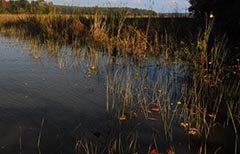
Wetlands
Bill Portlock/CBF Staff
Waters of the United States (WOTUS)
United States District Court for the District of Maryland
Chesapeake Bay Foundation, et. al. v. United States Environmental Protection Agency
Case Nos. 1:20-cv-01063, 01064 (consolidated)
The Clean Water Act was designed to “restore and maintain the chemical, physical, and biological integrity of the Nation’s waters.” To do this, the Act protects “navigable waters”—defined as “waters of the United States ”—from unregulated pollution and filling without a permit. However, because “waters of the United States” is not actually defined in the Clean Water Act, it has been subject to decades-long litigation and regulations attempting to clarify the definition. As a result, EPA and the U.S Army Corp of Engineers (Corps) collectively issued the 2015 Clean Water Rule. This Rule defined the wetlands and streams that qualify for federal protection under the Clean Water Act based on the connectivity of waters and the impacts streams and wetlands have on downstream water quality. Hundreds of streams and wetlands in the Chesapeake Bay watershed were protected under the 2015 Rule.
However, in 2019, in a rejection of sound science and legal precedent, EPA and the Corps embarked upon a two-step process to repeal and replace the 2015 Clean Water Rule. First the agencies finalized a repeal of the Rule entitled Definition of “Waters of the United States”—Recodification of Pre-Existing Rules (Oct. 22, 2019). CBF filed comments prior to the issuance of this rule as the repeal would reinstate the prior confusing regulatory regime and remove protections for certain water features like Delmarva Bays and pocosins (a wetland bog with sandy, peat soil) found in the Bay region. Thereafter, the agencies issued the final replacement rule entitled The Navigable Waters Protection Rule: Definition of “Waters of the United States” (Apr. 21, 2020). CBF and more than 2,000 of our members submitted comments opposing the replacement rule, which ignored leading science on the physical, chemical, and biological connections between streams and wetlands and navigable waters. Not only did this rule eliminate Clean Water Act protection for hundreds of streams and wetlands across the watershed, meaning a pollution discharger would no longer need a federal permit to release pollutants into these waters, it reduced the ability to prevent and control pollution harmful to the Bay and its tributaries.
As a result, CBF, together with ShoreRivers, challenged both the repeal rule and the Navigable Waters Protection Rule by filing two separate actions in U.S. District Court against EPA and the Corps on April 27, 2020 asking the court to vacate both rules and to reinstate the 2015 Clean Water Rule. On Aug. 24th CBF’s cases were consolidated. However, before final motions were filed, on February 2, 2021, the Court Ordered the cases to be held in abeyance as EPA reviewed the rules in accordance with President Biden’s Executive Order 13990- “Protecting Public Health and the Environment and Restoring Science to Tackle the Climate Crisis,” which establishes a policy to listen to science and improve public health and protect our environment.
On August 30, 2021, in a separate, but related case, the U.S. District Court for the District of Arizona vacated the April 2020 Navigable Waters Protection Rule. In light of this decision, the EPA and Army Corps announced the agencies’ intent to abandon the Navigable Waters Protection Rule, and instead rely on the pre-2015 regulatory regime and guidance from Supreme Court cases. CBF submitted comments on the Agencies’ request for pre-proposal feedback in September 2021 and we submitted comments on the Revised Definition of WOTUS in February 2022. EPA issued a revised definition, replacing both the 2015 Rule and the Navigable Waters Protection Rule in January 2023.
On June 17, 2022, CBF joined 113 environmental organizations and submitted an amicus brief, or friend of the court brief, in Sackett v. EPA, a case before the United States Supreme Court addressing which wetlands are waters of the United States and protected by the Clean Water Act. In May of 2023, the Supreme Court issued its opinion removing federal protection for a majority of wetlands and other waterways across the country. The Supreme Court’s decision also led EPA to revisit, and weaken, its January 2023 Rule. Following these significant changes to the legal and regulatory landscape, CBF and ShoreRivers filed a Motion to Dismiss both of our cases in July of 2023.
In September 2023, EPA issued an Amended version of its January 2023 Rule, incorporating the weakened standards required by the United States Supreme Court. CBF continues to monitor and engage with EPA and the states within the Chesapeake Bay watershed to ensure protection for wetlands and waterways.
This case was being handled by the former Vice President for Litigation Jon Mueller and Litigation Staff Attorney Ariel Solaski.
Henrico County Water Reclamation Facility
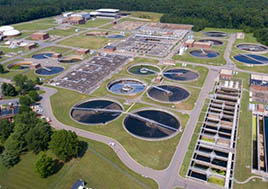
Henrico County
United States District Court for the Eastern District of Virginia
Chesapeake Bay Foundation, Inc. et al. v. County of Henrico
Case No.: 3:21-cv-00752
Updated: 3/8/2023
Henrico County Water Reclamation Facility (“Henrico WRF" Or "Facility"), located about five miles southeast of Richmond, receives sewage for treatment from Henrico County and portions of the City of Richmond, Hanover County, Goochland County, and other industrial plants. Through its operations, Henrico has discharged and continues to discharge raw sewage, pollutants, sediments, and bacteria into the James River in violation of the Federal Clean Water Act ("CWA") and the pollution limits in its Virginia Pollutant Discharge Elimination system (VPDES) permit. The Facility has been subject to at least 40 notices of violation and five different consent orders from the Virginia Department of Environmental Quality (“DEQ”) since it began its operations in November 1989.
As a result, on December 6, 2021, CBF and the James River Association who are represented by the Environmental Integrity Project ("Plaintiffs"), filed suit against the County of Henrico, the owner of the Facility, in the U.S. District Court for the Eastern District of Virginia. The suit sought to require the County to fix its failing sewage system and reduce impacts to public health and the Chesapeake Bay, and achieve compliance with the CWA and its VPDES Permit. In January 2022, Henrico filed a Motion to Dismiss the case which the Court denied in part and granted in part. The Court held that the Plaintiff's claims against Henrico could proceed but barred the Complaint's request for civil penalties under the CWA. Following this ruling, Plaintiffs filed a Motion for Reconsideration specifically related to whether the VA DEQ had “commenced” an enforcement action before litigation was initiated when it held a private meeting without public notice. The Judge denied the Motion following directed discovery and supplemental briefing on this issue. However, the 4th Circuit Court of Appeals issued a decision in a similar case supporting our arguments on commencement. As a result, the Court issued an order on August 1st vacating its previous ruling from April 11th.
A mandatory settlement conference was held on September 13, 2022 which resulted in an agreement being reached, by a joint effort of the parties, to settle the case. The Agreement proposed an Amendment to the County's December 2021 Consent Order, issued by DEQ, requiring the implementation of several corrective and preventative measures at the WRF. The draft amendment was out for public comment through February 15, 2023, and DEQ accepted the amendment on February 17th. As a result, Plaintiffs filed a Stipulation of Dismissal with the Court on February 27th, in accordance with the terms of the Agreement.
In addition to the Consent Order amendment, the Agreement requires Henrico County to invest $1 million to develop a supplemental environmental project by 2029. The project will be selected in collaboration with CBF and the James River Association. This project is an important step toward reducing pollution to the James River and its tributaries. The County will also develop a web-based map representing the location of Sanitary Sewer Overflows (“SSOs”) and undertake public notification measures.
CBF will continue to monitor the Facility and the environmental projects to ensure the terms of the Agreement are met.
CBF issued a Press Statement on March 1, 2023, announcing the Agreement. The Agreement can be found in its entirety here.
This case was led by CBF’s Environmental Justice Staff Attorney Taylor Lilley, Litigation Attorney Ariel Solaski, and attorneys from the Environmental Integrity Project.
Valley Proteins
United States District Court for the District of Maryland
ShoreRivers, Inc. et al. v. Valley Proteins
Case No.: 1:22-cv-00278
And
In the Circuit Court of Maryland for Dorchester County
State of Maryland Department of the Environment v. Valley Proteins
Case No.: C-09-cv-000022
Valley Proteins operates a poultry rendering facility that converts poultry by-products into feed fats and protein rich solids – processing 4.5 million pounds per week. The facility also operates an on-site private industrial wastewater treatment plant to treat discharged waste from the facility. The wastewater treatment plant operates under a National Pollutant Discharge Elimination System (“NPDES”) permit as an industrial facility that discharges to state surface waters. The facility, located in Linkwood, Maryland, discharges pollutants into the Transquaking River, which drains through Fishing Bay to the Chesapeake Bay.
Valley Proteins has a long history of violating the limits set in its NPDES permit. As a result, on April 13, 2022, CBF, and our partners ShoreRivers and Dorchester Citizens for Planned Growth, notified the owner and operator of the Valley Proteins facility of their intent to file a citizen suit in federal district court for violations of the Clean Water Act, the Resource Conservation and Recovery Act, and the Maryland Water Pollution Act.
CBF and partners then filed a complaint in the Federal District Court of Maryland against Valley Proteins, in February 2022, requesting that the court order Valley Proteins to comply with all permit terms and conditions. We also intervened in the Maryland Department of Environment’s (“MDE”) case against Valley Proteins in the Circuit Court of Maryland for Dorchester County. Both cases were stayed as CBF and partners met with Valley Proteins (which was recently acquired by Darling Industries) and MDE to discuss the terms of a proposed judicial consent decree (a legally binding agreement with the consent of all parties). On September 9, 2022, the parties reached agreement. The proposed Consent Decree requires Valley Proteins to pay $540,000 in civil penalties to the State of Maryland and provide $135,000 to CBF and partners for new Transquaking River monitoring and restoration work. The Consent Decree also requires Valley Proteins to conduct an investigation of potential sources of groundwater contamination at the facility, make improvements to stormwater management, and complete a plan to reduce odors emanating from the facility. The agreement also ensures enhanced oversight by MDE, CBF, and partners. The Consent Decree was filed with the Circuit Court for Dorchester County on September 12, 2022.
These cases are being handled by CBF’s Litigation Attorney Ariel Solaski.
Virginia Stormwater Management
United States District Court For the Western District of Virginia
Norfolk Southern Railway Company v. City of Roanoke
Case No.: 7:16-v-cv-00176
Updated: 5/1/19
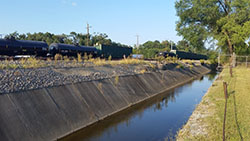
Jon Mueller/CBF Staff
The Commonwealth of Virginia instituted a program allowing localities the ability to assess fees from landowners, including corporate and individual citizens, to address stormwater carrying pollution that runs into local streams and rivers. As a result, The City of Roanoke established an Ordinance which generates revenue for stormwater management activities. The Ordinance institutes a fee assessment structure based upon the amount of impervious surface identified on improved parcels of land.
Norfolk Southern Railway Company (NSR) filed suit in the U.S. District Court for the Western District of Virginia, on April 12, 2016, seeking a partial exemption from the City's fee assessment. NSR claims the fees are unlawful under the Federal Railroad Revitalization Reform Act of 1976 because railroad tracks are not exempted from the City's Ordinance, but lawns are exempted. NSR also claims that the Ordinance violates the anti-discrimination provisions of the Federal Railroad Reform Act. The City of Roanoke filed a Motion to Dismiss the lawsuit on June 6th.
CBF filed a Motion For Leave to Intervene on July 8th as NSR's suit attacking the fee assessment threatens to challenge an important program by Virginia to fund stormwater management locally and reduce pollutants to the Chesapeake Bay.
A Hearing on CBF's Motion to Intervene was held on September 14, 2016 and on October 19th, the Court Granted CBF's Motion to Intervene under Federal Rules of Civil Procedure 24(b) allowing permissive intervention. As a result, CBF is now an intervenor-defendant in this case supporting the City of Roanoke and the fee assessment.
The Court also heard the City of Roanoke's Motion to Dismiss on September 14th. CBF provided arguments supporting the City's motion. After hearing arguments on both sides, on October 6th, the Court issued an opinion Denying Without Prejudice the Motion to Dismiss filed by the City. However, the Court narrowed the issues to whether the City's stormwater utility fee is a "tax" for purposes of the NSR, and not a fee. In addition, the Court allowed limited discovery on this single issue. The Discovery period closed on March 6, 2017. All parties filed cross motions for summary judgment on April 3rd. The City of Roanoke also renewed its Motion to Dismiss and a Motions Hearing was held on May 15, 2017. During the hearing, the Court instructed the City of Roanoke and CBF to respond to a newly minted argument presented by NSR related to the City's stormwater management system. Briefing on this issue was completed on June 15, 2017. On December 26, 2017 the Honorable Judge Conrad with the U.S District Court Granted the City of Roanoke and Chesapeake Bay Foundation's Motion for Summary Judgment ruling that the utility charge at issue in this case is a fee, rather than a tax. This is an important victory for the Chesapeake Bay as the City's program is designed to ensure proper management of urban stormwater.
On January 11, 2018, Norfolk Southern filed an appeal with the United States Court of Appeals for the Fourth Circuit located in Richmond, Virginia. After briefing was completed, Oral Arguments were held on November 1, 2018. On February 15, 2019, in a win for the Chesapeake Bay, the 4th Circuit issued a Published Opinion upholding the decision of the U.S. District Court requiring that Norfolk Southern pay stormwater utility fees to the City of Roanoke. In a concurring opinion, the Honorable Judge J. Harvie Wilkinson wrote: "Our rivers and estuaries are complex, interconnected ecosystems. It follows, therefore, that efforts to restore them are correspondingly complex and interconnected. Without the cooperation of all levels of government, as well as of private companies and citizens, our waters will continue to be compromised by pollution."
This case is being handled by CBF's former Vice President for Litigation, Jon Mueller, litigation staff attorney Brittany Wright, and staff counsel in the Virginia Office.
Washington Suburban Sanitary Commission
United States District Court for the District of Maryland
Potomac Riverkeeper and Chesapeake Bay Foundation v. Washington Suburban Sanitary Commission
Case No.: 14-CV-00417-TDC
Updated: 5/1/19

Lee Goodwin
The Potomac Water Filtration Plant, owned and operated by Washington Suburban Sanitary Commission (WSSC), provides the majority of the public drinking water supply in Montgomery County and Prince George's County, Maryland. The facility is located on the south branch of the Potomac River approximately 10 miles northwest of Washington, D.C. and within the Chesapeake Bay watershed. The plant removes water from the Potomac River, filters and disinfects it, transfers the treated water to a drinking water reservoir, and discharges the remaining wastewater back into the Potomac River. WSSC has chronically failed to meet monthly and daily effluent limitations for sediment and aluminum in the wastewater.
On February 12, 2014, CBF and Potomac Riverkeeper filed a lawsuit in the U.S. District Court of Maryland against WSSC for significant and ongoing violations of the Clean Water Act including National Pollutant Discharge Elimination System (NPDES) permit violations. Thereafter, the Maryland Department of the Environment (MDE) filed a Notice of Intent to Sue WSSC. CBF served WSSC with Interrogatories and Request for Production of Documents while settlement negotiations were ongoing and a consent decree was pending.
After over six months of settlement negotiations between CBF, co-plaintiff Environmental Integrity Project, WSSC and MDE, on October 20, 2015, WSSC's board voted unanimously to approve the Consent Decree and significantly reduce the amount of chemicals it releases into the Potomac River from one of its water purification plants. WSSC also agreed to pay a $100,000 state penalty and implement up to $8.5 million worth of short-term pollution control projects at the plant. After receiving comments from the United States Department of Justice pursuant to the Clean Water Act, the United States District Court granted an Order for Entry of the Consent Decree on April 15, 2016. Entry of the Consent Decree by the Court begins the process of planning and implementing Supplemental Environmental Projects CBF and its partner negotiated as a term of the Consent Decree.
The agreement is an important victory for clean water in the Potomac River and the Chesapeake Bay. In addition to the other commitments, WSSC will pay $1 million to for environmental projects that help reduce sediment pollution in the Potomac drainage area. WSSC will have up to ten years to complete the long-term improvements to the plant.
CBF's role continues as it evaluates WSSC's progress and completion of the Long-Term Upgrade Plan in order to fulfil the terms of the Consent Decree.
This matter is being handled by CBF Litigation Attorneys Paul Smail and Ariel Solaski, along with counsel from the Environmental Integrity Project.
Virginia Animal Feeding Operations
City of Richmond Circuit Court
Chesapeake Bay Foundation v. Commonwealth of Virginia, et al.
Case No.: CL-14002367-00
Updated 4/18/2016

The science is clear. Keeping cows out of streams like this one is an effective tool in farmers' arsenal of practices to improve water quality, and it improves the health of the cows.
Bill Portlock/CBF
On March 28, 2014, the Virginia State Water Control Board approved amendments to the Virginia Pollution Abatement Program General Permit and Regulation for Animal Feeding Operations (AFO). The amendments do not require livestock stream exclusion per the statutory requirements of the Virginia Code. Without stream exclusion regulations, livestock will excrete nutrient-laden waste, trample buffer vegetation, and erode stream banks, preventing the maintenance of buffer zones necessary to protect water quality.
On April 25, 2014, CBF filed a Notice of Appeal with the Virginia State Water Control Board and on May 23, 2014, CBF filed a Petition for Appeal with the Richmond Circuit Court. The Virginia Farm Bureau Federation, Virginia Agribusiness Council, Virginia Cattlemen's Association and the Virginia State Dairymen's Association have intervened in this case. Briefs were filed by the parties and a hearing was held on July 2, 2015.
On July 9, 2015, the Honorable Judge C.N. Jenkins, Jr. Affirmed the rulings of the Virginia State Water Control Board approving the amendments to the General Permit and the AFO Regulations. While in his ruling, the Judge recognized the importance of Bay restoration for a healthy Chesapeake Bay with the citizens of the Commonwealth, he also noted the limited nature of the Circuit Court's review.
Chesapeake Bay Foundation has decided to not appeal this matter and will continue to press the Commonwealth to fully fund its voluntary stream fencing programs.
This matter was being handled by CBF's former Vice President for Litigation Jon Mueller and staff counsel in the Virginia Office.
Concentrated Animal Feeding Operation (CAFO)
United States Court of Appeals for the Fourth Circuit
Louis Alt d/b/a Eight is Enough, et al. v. US EPA, et al.
Case No.: 13-2527
5/1/2015
In June, 2012, Lois Alt filed suit against the Environmental Protection Agency (EPA) challenging an Agency Order finding that Ms. Alt, as owner and operator of a poultry-broiler and concentrated animal feeding operation ("CAFO"), violated the Clean Water Act ("CWA") by discharging pollutants into waters of the United States without a National Pollutant Discharge Elimination System ("NPDES") permit.
In July, 2013, CBF moved to intervene in this matter. The district court denied CBF's intervention request as untimely and denied CBF the right to file an amicus brief. In a separate merits decision the district court held that EPA had no jurisdiction to order Ms. Alt to obtain a CWA permit, deciding that the polluted runoff from her farm was "agricultural stormwater," and was therefore exempt from CWA limitations. CBF appealed the intervention decision to the United States Court of Appeals for the Fourth Circuit. Food & Water Watch and EPA filed separate appeals of the merits decision.
Oral arguments in CBF's intervention case were held in May, 2014. In July, the Fourth Circuit affirmed the decision of the district court denying CBF's Motion to Intervene. In September, 2014, EPA and Food & Water Watch dismissed their appeal against Ms. Alt.
This matter was being handled by CBF's former Vice President for Litigation Jon Mueller.
EPA Petition Regarding Nutrient Pollution
United States District Court for the District of Columbia
Chesapeake Bay Foundation v. Stephen L. Johnson, Acting EPA Administrator
Case No.: 04-1959
Updated: 6/13/2005
In December 2003, CBF sent a petition to the U.S. Environmental Protection Agency (EPA) asking it to address problems with the Clean Water Act in the Chesapeake Bay region. Wastewater treatment plants were not being required to meet specific numeric limits for nitrogen and phosphorous—the primary causes of dead zones throughout the Bay.
When CBF had not received a response from EPA after a year, it filed suit in D.C. District Court to require EPA to respond to the petition. EPA's 61-page response, received June 13, 2005, declined to write rules requiring numeric nutrient limits in treatment plant permits, but it did do two things that essentially complied with CBF's petition:
EPA entered into an agreement with all six of the Bay states requiring them to place numeric nutrient limits in wastewater treatment plant permits once Maryland's water quality standards became final. Those standards were finalized on August 29, 2005.
EPA agreed that it would no longer waive reviews of permit applications for significant dischargers to Bay waters. This means that EPA will review every significant wastewater discharge permit issued in the Bay region.
In light of this agreement and EPA's response to its petition, CBF agreed to dismiss our suit in July 2015. However, CBF continues to review significant discharge permits issued by the Bay states to ensure that they comply with the law and the new agreement.
This matter was handled by outside counsel with assistance from CBF's Litigation Department.
CLEAN WATER ACT PERMIT CHALLENGES
Federal Construction Stormwater Permit
United States Court of Appeals for the District of Columbia Circuit
Chesapeake Bay Foundation, Inc and Potomac Riverkeeper v. United States Environmental Protection Agency
Case No.: 17-1039
Updated: 5/1/19
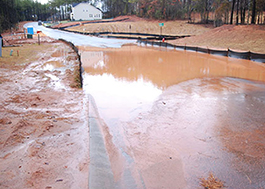
Poor erosion and sediment control on construction sites leads to sediment runoff into local waterways.
Catawba Riverkeeper.org
The U.S Environmental Protection Agency ("EPA") released a draft stormwater Construction General Permit (‘Permit") in 2015. The Permit covers basic erosion and sediment control runoff from construction sites under the Federal Clean Water Act. The Permit covers the states and tribal jurisdictions that have not been delegated authority to issue such permits. In the Chesapeake Bay watershed, only the District of Columbia is covered under this federal Permit. CBF provided comments on the draft Permit that was issued in 2015 with both American Rivers and the Potomac Riverkeeper joining us. In their comment letter, CBF raised issues related to the relatively small size of the District and the need for the permit to provide standards for the District alone, as well as shortening the standard period for how long soils on construction sites may remain un-stabilized from fourteen days to seven.
After reviewing the comments filed, on January 25, 2017, EPA issued the current Permit which became effective on February 16th. The National Association of Homebuilders ("NAHB") filed a Petition for Review of the Permit in the United States Courts of Appeals for the District of Columbia Circuit. CBF and Potomac Riverkeeper filed a separate Petition for Review on May 25th out of concern that NAHB could further challenge the minimum standards in the Permit. Since the standards in the federal Permit serve as the regulatory "floor" for States that issue their own construction stormwater permits, any weakening of the Permit would harm water quality in the Chesapeake Bay by allowing the discharge of additional sediment into local tributaries.
On May 25th, the Court issued an Order consolidating CBF and NAHB's cases. After months of settlement negotiations, EPA has agreed to reconsider and/or modify the general permit through the federal notice and comment proceedings. The proposed modification was published in the Federal Register in December 2018. CBF submitted comments on the modifications to the General Permit and will continue to monitor the developments.
This case is being handled by CBF Litigation Attorney Paul Smail.
Concentrated Animal Feeding Operation (CAFO)
Richmond Circuit Court
Jay Ford v. Commonwealth of Virginia, et. al.
Case No.: CL1802817
Updated: 8/1/2018
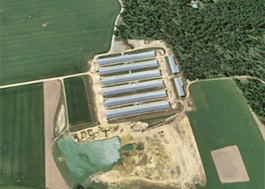
Poultry farms like this one on Maryland's Eastern Shore are considered concentrated animal feeding operations, or CAFOs.
Google Earth
On February 24, 2017, the Virginia Department of Environmental Quality (DEQ) proposed approval of water pollution discharge permits for three large poultry farms in Accomack County on Virginia's Eastern Shore, known as concentrated animal feeding operations (CAFO's). CBF submitted comments on the permits requesting that the waterbodies adjacent to the poultry houses be monitored for pollution discharges. However, the final permits issued by the Virginia State Water Control Board (SWCB) on April 12, 2018, contained very minimal monitoring requirements, even though the farms had previously been inspected and found to discharge pollutants to adjacent ditches that flow directly into tributaries of the Chesapeake Bay.
The Virginia poultry industry has been growing rapidly and since 2010 there has been a 13 percent increase in the number of birds regulated by the Virginia animal feeding operation program. These animal feeding operations are regulated under the EPA through the Clean Water Act National Pollution Discharge Elimination System (NPDES) program, or a state counterpart. CAFO's are required to apply for permits that control the pollution they discharge and allow for water quality monitoring.
Agriculture is one of the largest sources of pollution to the Bay and poultry farms are a major source of nitrogen and phosphorus pollution on the Eastern Shore. As a result, CBF represented a local community member and appealed the decision of the State Water Control Board on June 8, 2018, in the Richmond Circuit Court. After the appeal was filed a settlement was reached with DEQ providing that DEQ would undertake water quality monitoring at the three farms before and after rain events. As a result, the case was dismissed without prejudice on July 30, 2018.
This case was handled by CBF's former Vice President for Litigation, Jon Mueller and staff counsel in the Virginia Office.
Maryland MS4 Permit Challenges
Updated: 11/1/2016
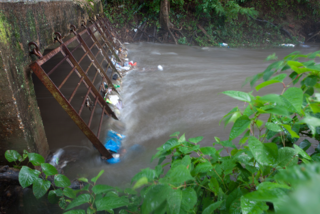
Krista Schyler/iLCP
Municipal Separate Storm Sewer Systems (MS4s) discharge polluted runoff from buildings, parking lots and roads. MS4 permits are issued to municipalities to ensure that the MS4 pollution is regulated pursuant to the Clean Water Act. MS4 permits have been issued by the Maryland Department of the Environment (MDE) that have insufficient limits and unenforceable terms, and are therefore allowing pollution to impact our local waters.
Maryland Court of Appeals
September Term, 2015; Nos. 43 and 44
CBF challenged the MS4 permit issued to Anne Arundel County by filing a Petition for Judicial Review on March 14, 2014 with the Circuit Court for Anne Arundel County. Oral arguments were held on November 10, 2014. The Circuit Court Judge affirmed the permit, granting MDE deference in its decision to issue the permit.
CBF and its partners West/Rhode Riverkeeper and Magothy River Association filed an appeal to the Court of Special Appeals on December 22, 2014 (Case No.: 1851-2014). This case was consolidated with the MS4 appeals filed by Earthjustice in Prince George's and Baltimore Counties.
Prior to oral arguments in the Court of Special Appeals for the consolidated cases in Anne Arundel, Prince George's and Baltimore Counties, on May 19, 2015, MDE filed a Petition for Writ of Certiorari with the Maryland Court of Appeals asking the high court to address two legal questions.
- Did the MS4 permits issued by MDE appropriately incorporate by reference publicly available materials?
- Was the Department's final decision to issue the permits with a 20% restoration requirement based upon the State's Chesapeake Bay TMDL strategies, and a reporting requirement to establish strategies to address wasteload allocations, supported by substantial evidence?
On November 5, 2015 the Maryland Court of Appeals heard oral arguments for the consolidated cases, the MS4 Permit issued in Baltimore City and MDE's appeal of the Court of Special Appeals decision in Montgomery County. (CBF filed an Amicus Brief in the Court of Special Appeals for the Montgomery County case on April 3, 2015. In this case, the court ruled in favor of Anacostia Riverkeeper holding that the county permit does not comply with Maryland law, the Clean Water Act and Federal Regulations).
On March 11, 2016, the Court of Appeals affirmed the Circuit Court rulings in Anne Arundel, Baltimore City, Baltimore County and Prince George's Counties. In addition, The Court of Appeals reversed the decision of the Court of Special Appeals and affirmed MDE's decision to issue the Montgomery County permit. CBF and our partners have filed a Motion For Reconsideration asking the Court of Appeals to revise a portion of its Opinion addressing the restoration plans required under the MS4 Permits. The Motion was denied on May 20, 2016. CBF continues to monitor MS4 permits and restoration plans throughout Maryland.
Maryland Court of Special Appeals
Case Number: 00773, September Term, 2015
CBF also filed a Petition for Judicial Review of the MS4 permit issued in Howard County on January 16, 2015. However, Howard County filed a Motion to Dismiss CBF's Petition for Judicial Review alleging lack of standing and a hearing was held on May 19, 2015. The Circuit Court ruled in favor of the County and granted its Motion to Dismiss. CBF filed an appeal of this decision to the Maryland Court of Special Appeals. CBF's filed its principle brief on December 18, 2015 and the County's Brief was filed on February 19, 2016. However, CBF dismissed their appeal on March 16, 2016 as a result of the Court of Appeals March 11, 2016 Decision.
Circuit Court Proceedings
CBF filed Petitions for Judicial Review of the MS4 permits issued in December 2014 and January of 2015 to the following Maryland Counties:
Charles County—Case No.: 08-C-15-000136
Carroll County—Case No.: 06-C-15-068113
Frederick County—Case No.: 10-C-15000259
Harford County—Case No.: 12-C-15000220
The Counties also filed a separate Petition for Judicial Review of the MS4 permits issued by MDE at or near the same time CBF filed their Petitions.
CBF, MDE, and the Respondent Counties initially requested a Stay of these Proceedings pending the resolution of the cases in the Maryland Court of Appeals. After the Maryland Court of Appeals cases were decided, CBF filed Motions with the respective counties to Consolidate CBF's cases with the Counties Petitions. A Hearing was held in Carroll County on October 21, 2016 and the Court dismissed CBF's case without ruling on our request for consolidation. Based on this result, and the likelihood of similar outcomes in the other three counties, CBF filed Motions to Dismiss our cases in Charles, Frederick, and Harford Counties.
CBF believes this is an appropriate step to take in order to redirect its resources and efforts to monitor compliance with the MS4 permits. We will take appropriate action, if necessary, to help protect and restore the Chesapeake Bay and its tributaries if the various jurisdictions do not fulfill their obligations under the terms of the MS4 permits.
These cases were being handled by CBF Litigation Attorney Paul Smail and litigation staff.
Tricity Wetlands Permit
Court of Appeals of Virginia
Chesapeake Bay Foundation v. Commonwealth of Virginia
Case No. 1897-12-2
Updated: 5/1/2015
In December, 2003, CBF and others appealed the issuance of a state Water Protection Permit to Tri-City Properties to the Circuit Court of the City of Richmond. The permit allowed for the destruction of 181 acres of protected, nontidal wetlands in Chesapeake, Virginia near the Stumpy Lake Nature Preserve.
Since the first filing in 2003, this case has been through the Virginia Courts several times. Standing—or the right of CBF to bring a lawsuit on behalf of itself and its members—has been challenged by the Commonwealth several times. Each challenge by the Commonwealth was denied; however, the lower courts continued to uphold the merits of the State Water Control Board's decision.
On December 9, 2013, oral arguments were held in the Virginia Court of Appeals where the court considered whether CBF's appeal should be dismissed because the circuit court failed to issue a written opinion or to provide CBF a copy of an earlier order. The Court of Appeals issued a divided opinion on several issues, but ultimately affirmed the lower court's decision. Because of the nature of the opinion, CBF did not appeal the decision, but continues to monitor any efforts to develop the site and take appropriate action.
This matter was handled by outside counsel, Robert Wise, on a pro bono basis with assistance from CBF's Virginia office and the Litigation Department.
Pennsylvania and West Virginia Water Permits
Updated: 10/21/2012
In 2008 and into 2009, numerous municipalities in Pennsylvania and West Virginia filed administrative and judicial appeals challenging permits regulating their discharge of wastewater into tributaries of the Susquehanna and Potomac Rivers. These challenges claimed that the nitrogen and phosphorous limits imposed by the permits were invalid because they were based upon wasteload allocations generated as a result of Chesapeake Bay water quality standards. These allocations were adopted by state agencies as part of their tributary strategies created following the Chesapeake 2000 Agreement. The municipalities argued that they should not be bound by the tributary strategies as the strategies had not been approved by their state legislatures.
CBF supported the state agencies in court arguing that the stricter limits translated into fewer nutrients going into the Chesapeake Bay.
These matters were handled by former CBF staff attorney Amy McDonnell.
Merck Permit Challenge
Circuit Court for the City of Richmond
Chesapeake Bay Foundation v. Commonwealth of Virginia
4/1/2011
In April of 2009, the Virginia Water Control Board approved a recommendation from the Department of Environmental Quality (DEQ) to raise the allotted limit on the amount of nutrients Merck's Stonewall Plant could discharge into the Shenandoah River, a tributary to the Chesapeake Bay. Originally, the pharmaceutical manufacturer was permitted to discharge 14,619 pounds of nitrogen and 1,096 pounds of phosphorous from its wastewater-treatment facility into the River each year.
The new allocations allowed the plant to discharge 43,835 pounds of nitrogen and 4,384 pounds of phosphorous per year. In an attempt to offset the new loads, the Board directed Merck to identify companies that were no longer releasing nutrients or were discharging fewer nutrients to the Shenandoah River than their permits required; there was no requirement that Merck identify such offsets prior to being granted a permit amendment. Importantly, there was no guarantee that the offsetting loads identified by Merck would continue into the future to ensure a continuous offset.
In May 2009, CBF and the Virginia State Waterman's Association filed a notice of appeal with the Circuit Court for the City of Richmond. However, after the publication of the Bay TMDL which independently set nutrient load allocations for sources like Merck, the parties began negotiations in an attempt to reach a settlement. This was met by success in April of 2011 with the lodging of a consent decree approved by Richmond Circuit Judge Melvin R. Hughes Jr., which required Merck's nitrogen and phosphorus discharges to conform to EPA's guidelines for pollution flowing into the Bay.
This matter was handled by CBF's former Vice President for Litigation Jon Mueller and Virginia Office Attorney Peggy Sanner.
Elizabeth Wilson Wastewater Treatment Plant
Updated: 9/30/2009
Early in 2007, the Maryland Department of the Environment (MDE) issued a discharge permit that allowed for the construction of an individual wastewater treatment plant at a private residence located on Bungay Creek in Kent County. The Creek flows into West Langford Creek, which flows into the Chester River and ultimately the Bay. The land on which the treatment plant was proposed did not pass a percolation test, thus a septic system could not be installed. Without some sort of wastewater system, a house could not be built on the property. The owners sought the discharge permit to circumvent this restriction. One of the permit's requirements was that the owners preserve and maintain five acres of land to "offset" wastewater discharges to the Creek. At the time the permit was granted, Maryland did not have a formal "offset" policy and there were no rules in place to guide the agency in quantifying how much land would be needed to offset a new discharge to the creek.
Because CBF believed that such a permit, if left unchallenged, would only lead to more construction in the sensitive Critical Area and further harm water quality, we requested reconsideration of the permit. However, in June 2008 MDE decided to go forward with finalizing the permit. Subsequently, CBF appealed the final permit to the Maryland Circuit Court for Kent County. On March 20, 2009, the Circuit Court upheld the permit.
The permit decision was appealed to the Court of Special Appeals, but the appeal was dismissed in September 2009 due to the passage of a new law. During the course of this case and largely as a result of CBF's efforts, the Maryland General Assembly passed legislation in 2009 that would prohibit the issuance of similar permits in the future.
Blue Plains Sewage Treatment Plant
U.S. Court of Appeals for the D.C. Circuit
D.C. WASA v. EPA et al.
Updated: 8/6/2009
In April 2007, the U.S. Environmental Protection Agency (EPA) issued a pollution discharge permit for the District of Columbia's Blue Plains sewage plant, the largest single source of nitrogen and phosphorous pollution in the Chesapeake Bay watershed. The Blue Plains plant discharges an average of 6.3 million pounds of nitrogen each year into the Potomac River, a tributary to the Bay.
While CBF approved of the limits placed on the amount of nitrogen and other nutrients that could be discharged by the plant, we objected to the fact that the permit did not include a compliance schedule or deadline for the plant to construct the necessary equipment to meet the limits — even though local D.C. and federal laws require that the permit contain such a schedule.
Consequently, in May of 2007, CBF filed an administrative appeal of the permit with EPA's Environmental Appeals Board. In March of 2008, the Board issued its opinion upholding the permit limits and agreeing with CBF that the permit was invalid for failing to contain a compliance schedule. Blue Plains then requested reconsideration of the decision, but the Board declined. Blue Plains appealed the Board's decisions to the U.S. Court of Appeals for the District of Columbia. However, because the permit was not final and was being redrafted by EPA to comply with the Board's decision, the appeal was dismissed early in 2009. A revised permit consistent with CBF's objectives has been issued.
This matter was handled by CBF's former Vice President for Litigation Jon Mueller.
King William Reservoir
Updated: 7/1/2009
This matter concerned both the federal and state permitting of a proposed reservoir in King William County, Virginia. If built, the reservoir project would have been the largest permitted wetlands destruction in the Mid-Atlantic region—over 430 acres.
U.S. District Court for the District of Columbia
Alliance to Save the Mattaponi et al. v. U.S. Army Corps of Engineers et al.
In 2001, after more than 10 years of studies and research, the Norfolk District of the U.S. Army Corps of Engineers denied a Clean Water Act permit for the proposed King William Reservoir project. However, then-Governor James Gilmore requested the decision be reconsidered by the Corps' North Atlantic Division. In 2005, the Division decided to issue the permit. CBF, along with several co-plaintiffs, appealed the issuance of the permit to the U.S. District Court for the District of Columbia. Based on an additional claim made by the Mattaponi Indian Tribe in the same case, CBF eventually added a second claim to the complaint against the U.S. Environmental Protection Agency (EPA) for failing to exercise its power to stop the Army Corps from issuing the permit.
In 2009, the U.S. District Court reversed the decision to issue the permit and sent it back to the Army Corps for further consideration. The Court also found that EPA had not sufficiently detailed its reasons for not exercising its authority to deny the permit. The full decision was appealed by the EPA to the U.S. Court of Appeals for the D.C. Circuit in June of 2009, but was shortly dismissed based on agreement of all the parties. As a result, the U.S. Army Corps suspended the permit and ordered Newport News to provide additional information supporting the permit. The project was officially terminated in October 2009 upon a decision of the City of Newport News to abandon the project.
This matter was handled by CBF's former Vice President for Litigation Jon Mueller along with counsel from the Southern Environmental Law Center. The University of Virginia's Environmental Law Clinic also provided support.
Virginia Court of Appeals
Chesapeake Bay Foundation v. Commonwealth of Virginia
Virginia's Department of Environmental Quality (DEQ) issued a permit in 1997 to the City of Newport News to allow construction and operation of the proposed King William Reservoir. It gave the city 10 years to complete the project. However, by 2006 the reservoir project had not yet begun and Newport News sought an extension of time from the Virginia State Water Control Board. The Board initially denied the extension and, at the request of Newport News, decided to reconsider three months later. In an unprecedented decision, the Board granted the extension in December of 2006. As CBF believed this decision was contrary to legally required procedures and asked for a formal hearing before the Board but were denied.
CBF appealed the Board's decision to grant the permit extension to the Circuit Court for the City of Richmond, and litigated the case—including defense of its standing to sue—through appeals to the Virginia Court of Appeals and eventually the Virginia Supreme Court. However, based on the suspension of the federal permit and the subsequent abandonment of the project by Newport News, the state appeal was dismissed as moot.
This matter was handled by CBF's Virginia Office and former Vice President for Litigation Jon Mueller.
Philip Morris Wastewater Permit
Updated: 4/20/2007
In the summer of 2004, CBF sued the Virginia Department of Environmental Quality (DEQ) for failing to require lower nitrogen limits in Philip Morris' wastewater discharge permit. In January 2005, the Chesterfield County Circuit Court held that CBF could not bring such a case because it lacked standing - CBF would not suffer any harm due to the permit and CBF could not represent its members. CBF filed an appeal with the Virginia Court of Appeals, which overturned the Circuit Court decision in April 2006. The Commonwealth and Philip Morris appealed this decision to the Supreme Court of Virginia. CBF trustee, Tayloe Murphy, submitted an amicus curiae brief in support of CBF.
On April 20, 2007, in a unanimous decision, the Supreme Court of Virginia upheld the Court of Appeals' decision and ruled for the first time that a citizen group can sue both on its own behalf and on behalf of its members. See Philip Morris USA, Inc. v. Chesapeake Bay Found., Inc., 273 Va. 564, 581 (Va. 2007). Consistent with CBF's argument, the Court held that the standard to be applied is the same as the federal standard under Article III of the United States Constitution. CBF's petition alleged that the permitted discharges have "and will continue to cause injury to CBF and its members who regularly use and enjoy the James River, a tributary of the Chesapeake Bay, for swimming, boating, kayaking, canoeing, sport fishing, and other educational and recreational pursuits." The court held that these facts alone alleged "actual and ongoing injury to the recreational interests of members of CBF sufficient to satisfy" federal law and created legally protected interests, not generalized grievances of the public. Further, the injuries alleged were traceable to the permitting decision because the discharges would excessively increase the amount of nutrients in the James River and lead to harmful algae blooms. This ruling does not only apply to challenges to wastewater permits issued under the state Clean Water Act but to all state statutes that contain a reference to the requirements of Article III of the United States Constitution.
While the lawsuit was pending, DEQ issued regulations requiring Philip Morris to reduce its nitrogen load by January 2008 and its phosphorous load by 2011. Subsequently, CBF, the State, and Philip Morris agreed to settle the lawsuit. Under a settlement agreement approved by the Circuit Court, Philip Morris agreed to comply with the reduced nitrogen and phosphorous load limits effective immediately. The settlement concluded this matter in favor of CBF, the James River and the Bay.
The litigation was handled by CBF's former Vice President for Litigation Jon Mueller and former Virginia staff attorney Joe Tannery.
Town of Onancock
Updated:4/30/2005
In the summer of 2004, CBF sued the Virginia Water Control Board and the Department of Environmental Quality (DEQ) for failing to require nitrogen and phosphorous limits in the Town of Onancock's wastewater plant discharge permit. In April 2005, a hearing was held in the City of Richmond Circuit Court on CBF's motion for summary judgment. Despite evidence to the contrary, the court held that CBF had not established that the Water Board had issued a flawed permit and dismissed the case.
However, largely in response to this suit and another brought by CBF concerning the Philip Morris plant outside of Richmond, DEQ set stricter limits for the Onancock plant and the town agreed to upgrade its facility. Therefore, instead of appealing the decision, CBF and DEQ asked the Court to dismiss the case. The agreement between CBF and DEQ provides that the circuit court decision will have no effect on the current law.
This matter was handled by outside counsel, Robert Wise, on a pro bono basis with assistance from CBF's Virginia office and the Litigation Department.
FOREST CONSERVATION
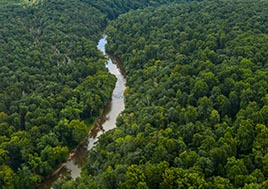
John Pavoncello/York Dispatch
Abingdon Business Park
Appellate Court of Maryland
Chesapeake Bay Foundation, Inc. v. CREG Westport I, LLC, et al.
Case No.: CSA-REG-1063-2020
Updated: 8/1/2024
Forest Conservation Plan
On December 9, 2019, the Harford County Director of Planning and Zoning (“Planning Director”) approved a Forest Conservation Plan for Abingdon Business Park. The developer’s (CREG/Westport I, LLC) plan includes warehouse facilities and other mixed uses on approximately 330 acres of forested land in Harford County, Maryland. The site contains part of the Haha Branch stream, which drains into the Bush River and, ultimately, the Chesapeake Bay. The downstream Bush River is already classified as impaired for high levels of sediment from stormwater runoff. In addition, the Forest Conservation Plan permits the clearing of over 200 acres of forested land and the removal of 49 old and large trees known as “specimen trees.”
On January 8, 2020 CBF, together with nearby property owners, filed a Petition for Judicial Review with the Circuit Court for Harford County contesting the Planning Director’s decision to approve the forest conservation plan. We alleged that it did not meet the requirements of the Harford County Zoning Code. The County and the Developer together filed a Motion to Dismiss the Petition in March of 2020 and CBFs filed an opposition. After a hearing was held, the Court granted the Motion to Dismiss holding that the Forest Conservation Plan was not a “final decision” and therefore did not provide Petitioners with the ability to appeal. CBF believed that this decision was inconsistent with state law. We filed an appeal to the Appellate Court of Maryland (formally the Maryland Court of Special Appeals). Oral Arguments were held virtually on June 14, 2021, and on September 8, the appellate court issued an Opinion affirming the decision of the circuit court and ruled that the forest conservation plan was not a “final decision” subject to appeal.
We filed a Petition for Certiorari with the highest court in Maryland, the Supreme Court of Maryland (formally the Maryland Court of Appeals), asking the court to review this decision. The Court granted our petition and on August 26th after briefing and arguments were held, the court subsequently ruled in our favor and reversed the prior decisions. The court held that CBF could appeal the forest conversation plan and that forest conservation plans for development projects can be legally challenged after being approved. This decision has far-reaching implications for forest conservation in Maryland and will give forests the same legal protections as wetlands and waterfront lands in Maryland.
See CBF’s press statement on this landmark decision.
Our initial Petition challenging the Forest Conservation Plan was then heard on the merits in the Circuit Court for Harford County in January 2023. On May 10, 2023, the Court ruled in our favor and found that Harford County did not provide a factual basis for granting a waiver from the requirements of the Forest Conservation Act to clear the specimen trees and remanded the Forest Conservation Plan back to the County for further review. This is another major victory for citizens to ensure that the Forest Conservation Act can be used to protect important forested land and the significant mature specimen trees. The developer and landowner appealed this decision to the Appellate Court of Maryland on July 31, 2023. In July 2024, the developer and landowner dismissed the appeal after the parties to the case reached a settlement.
See CBF’s Press Statement: Harford County Settlement to Require Abingdon Woods Reforestation, Limit Future Development
Grading Permit
While our appeal of the Forest Conservation Plan was pending, the Harford County Department of Public Works issued a grading permit for the Abingdon Business Park Development. Issuing the grading permit allowed the developer to begin clearing forest land and specimen trees. CBF filed an appeal of the grading permit, a Motion for Temporary Restraining Order, and Preliminary Injunction with the Circuit Court for Harford County to stop any further tree removal. The County filed a Motion to Dismiss our appeal. After the court denied our request for the temporary restraining order, we filed a renewed request when the Maryland Court of Appeals found in our favor in the Forest Conservation matter, and we provided additional evidence regarding the irreparable harm that would be caused by further tree removal. The Court granted our request for a temporary restraining order on all tree clearing at the site. The parties reached a mutual agreement whereby the developers were enjoined from further cutting of trees associated with the Abingdon Business Park until the final resolution of CBF’s initial Petition for Judicial Review of the Forest Conservation Plan. This matter was stayed pending appellate court review of the developer’s appeal noted above. As a result of the settlement agreement reached, this case was dismissed on July 15, 2024.
CBF was represented in these cases by the Vice President of Litigation Paul Smail.
Hazardous Waste
Sparrows Point
Updated: 5/1/19
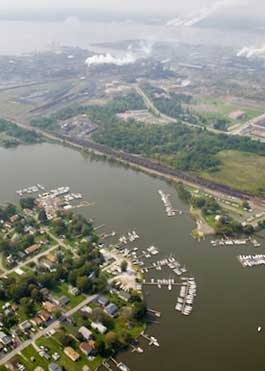
Nikki Davis
The Sparrows Point steel mill is located on the banks of the Patapsco River in Baltimore, Maryland. The original owner, Bethlehem Steel Corporation (BSC), operated on the roughly 2,300 acre site for more than 80 years, making iron and steel and building ships. Hazardous wastes were deposited on the site and in the adjacent waterways.
In the late 1990s, the U.S. Environmental Protection Agency (EPA) and the Maryland Department of the Environment (MDE) sued BSC for numerous hazardous waste violations. The case was settled in 1997 when the parties signed a consent decree that required BSC and any subsequent owner to correct the violations, perform the necessary studies to fully evaluate the site, and cleanup the pollution both on- and off-site. BSC declared bankruptcy in 2000 and ownership of the property has changed hands several times since. The Russian steel company Severstal took ownership from ArcelorMital in 2008 but sold the site in 2011 – RG Steel (a subsidiary of The Renco Group) took control of the mill at this time. RG Steel went on to file for bankruptcy protection in Delaware federal court a year later.
The Chesapeake Bay Foundation has been directly involved in a number of federal lawsuits and bankruptcy proceedings related to the Sparrows Point facility, including Chesapeake Bay Foundation et al v. RG Steel Sparrows Point, RG Steel Sparrows Point v. EPA and MDE, and RG Steel's filing for bankruptcy in federal court in Delaware.
U.S. District Court for the District of Maryland
Chesapeake Bay Foundation et al. v. RG Steel Sparrows Point
Case No. 1:10-cv-01861-JFM
Concerned with local water quality and human health in the areas surrounding the steel mill, CBF, Baltimore Harbor Waterkeeper, and several local residents joined together in 2009 and sent a notice of intent to sue to the owners of the steel facility as well as the agencies charged with oversight of environmental compliance on and around the property.
In 2010, after efforts to resolve our concerns without litigation failed, a citizen suit was filed in federal court against past and then present owners Arcelor Mittal and Severstal. The lawsuit asked the court to order the steel companies to fully investigate off-site contamination and, if necessary, to remove and remediate the off-site contamination; to take emergency measures to more fully prevent pollution leaving the facility; and to obtain appropriate hazardous waste and erosion and sediment control permits.
This case was stayed by the Court following the 2012 bankruptcy petition of RG Steel Sparrows Point.
U.S. District Court for the District of Maryland
RG Steel Sparrows Point v. EPA and MDE
Case No. 1:97-cv-00558-JFM
Although under the terms of the 1997 consent decree with Bethlehem Steel Company (BSC) clean-up of the steel mill site is the responsibility of any subsequent owner, Severstal contended that because it had purchased the property as part of BSC's bankruptcy, subsequent owners were not legally obligated to investigate and remediate contamination that had migrated beyond the steel mill property and into the surrounding water. In July of 2010, under a provision of the consent decree, Severstal filed a petition with the District Court arguing that EPA and MDE could not make it examine offsite contamination. The steel companies argued that the bankruptcy sale of the property in 2003 effectively released them from environmental liability for releases of hazardous waste that occurred prior to BSC's bankruptcy. CBF and its co-plaintiffs in the permitting case filed a motion to intervene due to their substantial interest in the case.
In September of 2010, Severstal and Arcelor Mittal opposed CBF and its allies' right to intervene. The Court issued an opinion on July 5, 2011 allowing CBF and the individual citizens to intervene in the dispute resolution case because their interests were affected by further implementation of the 1997 consent decree. The Court also decided that current owners are responsible for existing on-site releases of contamination from the steel facility and that they are not relieved of their obligation to conduct a Site Wide Investigation (SWI) that includes offshore sampling of current and past releases.
However, the Court also found that the bankruptcy sale of the steel mill by BSC cut off the obligation of any subsequent owner to remediate pollution released from the site prior to the date of sale, 2003. In an effort to resolve the dispute without judicial intervention, the Court ordered the parties to try and reach an agreement on the scope of the offshore investigation. CBF participated in negotiations; however, the agencies did not recognize CBF's scientific arguments that the scope of the offshore investigation was too limited and CBF was obliged to file an objection to the settlement reached between the governments and RG Steel.
On March 15, 2012, District Court Judge J. Frederick Motz denied CBF's objections and formally approved the offsite investigation agreed upon by RG Steel, EPA, and MDE. As a result, on May 2, 2012, CBF along with our partners, including the Baltimore Harbor Waterkeeper, appealed his decision to the U.S. Court of Appeals for the Fourth Circuit. However, due to RG Steel's bankruptcy filing, on October 25, 2013, the case was sent back to Judge Motz to decide whether the bankruptcy precluded resolution of the appeal. Recognizing that the bankruptcy blocked the ability of the District Court to act, CBF voluntarily dismissed its appeal, but convinced the agency to rescind the prior offsite work plan proposed by RG Steel. As a result, on January 13, 2014, Judge Motz ordered that RG Steel's obligation under the offsite investigation agreement be extinguished and the March 15, 2012 Order was vacated opening the door for a comprehensive offsite investigation.
U.S. Bankruptcy Court for the District of Delaware
In Re: RG Steel Sparrows Point
Case No. 12-11661
In May of 2012, RG Steel filed its notice of voluntary bankruptcy in federal court in Delaware. A few months later, the Sparrows Point steel mill was up for auction. Environmental Liabilities Transfer (ELT) and Commercial Development Co. (CDC) (representing a third party, Hilco) made the highest bid of $72 million. A draft bankruptcy sale order followed. CBF, EPA and MDE argued to the bankruptcy court that the sale order was deficient because, among other things, it failed to contain a provision obligating the new purchasers to fulfill the outstanding environmental obligations under the BSC consent decree and to perform the off-site investigation. CBF, EPA and MDE successfully negotiated with RG Steel for a provision in the bankruptcy sale order that obligated the buyers to perform all outstanding work required under the consent decree. In addition, $500,000 was set aside from the sale proceeds to fund the off-site investigation.
Cleaning-Up Sparrows Point
It has been nearly two decades since EPA and MDE signed a consent decree with the then owners of the Sparrows Point Steel Mill resolving litigation for numerous federal and state hazardous waste violations. However, other than removal of chromium from groundwater beneath the Rod and Wire Mill, very little clean-up of hazardous waste has occurred since then. In fact, environmental monitoring suggests that hazardous waste continues to leave the site from the Coke Point area, contaminating the adjacent Patapsco River and Bear Creek.
The new owner of the site, Sparrows Point Terminal, LLC, now known as Tradepoint Atlantic (TPA), entered into a settlement agreement with EPA and an administrative consent order with MDE. The agreement with EPA waives claims for contamination found offshore of the plant site which left the site prior to SPT's purchase of the property. In exchange, TPA committed $3 million to investigate and remediate offshore contamination. Under the consent order, TPA has committed $46 million to undertake investigation and remediation work on the former steel mill property.
CBF continues to monitor the progress of the on-site work, the offshore investigation, and the new owner's voluntary cleanup efforts. When EPA refused to study the toxicity of the sediments offshore from the plant site, we hired an outside consultant to analyze sediment collected from the river bottom for toxicity. Several of those samples were found to be toxic to bottom dwelling organisms and fish. CBF also continues to advocate for the new owners' compliance with state and federal environmental laws and to ensure it will undertake all necessary on-site work in accordance with the consent decree as well as federal and state law.
CBF and Blue Water Baltimore have filed joint comments on several environmental remediation measures, including the proposed remedy for Tin Mill Canal, which has long been recognized by EPA and MDE for hazardous waste activities. CBF's litigation team continues to press EPA and MDE for adequate groundwater monitoring for the Tin Mill Canal site. We also continue to monitor and comment on authorizations for dredging associated with the redevelopment of the site.
All Sparrows Point matters are being handled by CBF's former Vice President for Litigation Jon Mueller and Litigation Attorney Paul Smail, along with counsel for Blue Water Baltimore, Inc.
MORE INFORMATION ABOUT SPARROWS POINT
Hydropower
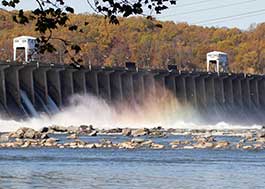
Eliot Malumuth
Conowingo Dam Relicensing
United States Court of Appeals for the D.C. Circuit
Waterkeepers Chesapeake, et al., v. Federal Energy Regulatory Commission
Case No.: 21-1139 (consolidated)
Since its construction in 1928, the Conowingo Dam, owned and operated by Exelon, on the Susquehanna River in Maryland has been trapping sediment and phosphorus pollution in the reservoir behind the structure. Today the reservoir is almost completely filled and, as a result, has lost much of its capacity to trap sediment and nutrients. In particular, during heavy rainstorms when the flow through the dam is high, these sediments are scoured from the reservoir and released into the river below. This results in a high amount of pollution flowing into the Bay in a short period, rather than gradually, which can overwhelm the Bay and fuel algal blooms that cause dead zones devoid of oxygen in the Bay.
CBF has a long legal history of involvement with the Conowingo Dam beginning in August 2013 when we first intervened in the Federal Energy Regulatory Commission’s (FERC) relicensing proceedings for the dam, provided comments on FERC’s Draft Environmental Impact Statement (DEIS), and Exelon’s Section 401 Water Quality Certification application with the State of Maryland. Eventually MDE issued its Certification on April 27, 2018, requiring Exelon to account for and reduce the amount of nitrogen and phosphorus discharged through the dam due to the inability of the dam to continue trapping these pollutants. In response to MDE’s certification, Exelon filed Judicial actions against MDE in May 2019 in both Maryland state court and federal court. CBF filed Motions to Intervene in both cases to ensure that the proper administrative process was followed and defend the State of Maryland’s authority to certify and condition discharges that would otherwise harm water quality.
However, prior to the cases being litigated, the State of Maryland filed a Settlement Agreement with FERC that would resolve all of Exelon's judicial and administrative appeals. The settlement waived the requirement for a water quality certification and required Exelon to invest approximately $200 million adjusted for inflation over the 50-year license agreement term for environmental benefit projects, while not admitting any responsibility or liability for pollution scoured and discharged from the dam during high river flow events such as storms. On January 17, 2021, CBF filed comments on the Settlement Agreement with FERC urging the commission to reject the proposed settlement offer. However, on March 19, 2021, FERC issued an Order granting a new 50-year license to Exelon without imposing any conditions on the operation of the Dam that would mitigate its impact to downstream water quality.
CBF, along with our partners Waterkeepers Chesapeake, Lower Susquehanna Riverkeeper, and ShoreRivers, represented by Earthjustice, filed a request for a rehearing of FERC’s March 19th Order. After FERC denied our request, we filed a Petition for Review with the United States Court of Appeals for the D.C. Circuit on June 17, 2021, requesting the Court review FERC’s Order to issue the new license and a 2nd Petition for Review on September 13th based on FERC’s Order on our rehearing request. Arguments were held on October 11, 2023.
In a win for the Chesapeake Bay, watermen, and residents downstream from the Dam, the D.C. Circuit Court of Appeals issued an opinion on December 20, 2022 vacating FERC’s 50-year license issued to Constellation Energy (formerly Exelon) to continue operating the Dam. The Court found that FERC violated the Clean Water Act when it issued the license without including the water quality certification that MDE had issued in 2018.
MDE is currently reconsidering the Water Quality Certification for the Dam and solicited public comments in August 2023. CBF is closely monitoring the license review process and providing input and comments where appropriate.
CBF was represented in this matter by the Vice President of Litigation Paul Smail.
Conowingo Dam Fish Passage
Department of the Interior
Updated: 4/27/2016

Jay Fleming/iLCP
On October 1, 2015, Chesapeake Bay Foundation and the Midshore Riverkeeper Conservancy (MRC) jointly filed a Notice to Intervene in an administrative "trial-type hearing" sought by Exelon Generation Company, the owner of the Conowingo hydroelectric dam on the Susquehanna River. The Department of the Interior U.S. Fish & Wildlife Service (USFWS) had issued certain prescriptions for operation of the dam to improve fish passage. Exelon requested this hearing to challenge facts relied upon by USFWS as part of the relicensing of the dam before the Federal Energy Regulatory Agency (FERC).
The proceedings are regulated under The Federal Power Act which requires a "fishway prescription" for the dam license to "provide for the safe, timely, and effective passage of fish" upstream and downstream of the dam. Once finalized by USFWS, the fishway prescription is mandatory and FERC must require it in the hydropower license.
The trial-type hearing is a fairly new layer of administrative review added to the prescription process by the Energy Policy Act of 2005, and includes motions, discovery, and a hearing prior to a decision from the Administrative Law Judge. CBF's intervention would have allowed it to participate in the hearing. In October of 2015, the trial-type hearing process was stayed to allow the parties to conduct settlement discussions.
On April 25, 2016, the USFWS and Exelon announced that they had reached an agreement for fish passage measures at the Conowingo Dam. Although CBF and other environmental intervenors participated in the settlement negotiations, they did not sign on to the agreement.
The agreement includes an adaptive management process that will require fishway improvements throughout the license term based on modeling and monitoring data; trap-and-transport of American eels until at least 2030 when a volitional eel passage structure will be installed; immediate improvements to the East Fish Lift; and trap-and-transport of up to 100,000 American shad and 100,000 river herring annually. The agreement is an important part of the long-term recovery strategy towards the population goals set by the Susquehanna River Anadromous Fish Restoration Cooperative: 2 million American shad and 5 million river herring spawning upstream of York Haven dam.
This matter was handled by CBF Litigation Attorney Ariel Solaski.
Land and Use and Zoning Cases
Maryland Court of Special Appeals
Friends of Frederick County et al v. Board of County Commissioners
Case No.: 01259.September Term, 2013
Updated: 8/30/2015
In 2010, the Frederick Board of County Commissioners adopted a new Comprehensive Plan and Zoning plan after two years of studies, reviews and public input. Shortly thereafter, a new Board took office and quickly amended the zoning map associated with the plan to "up zone" certain farm properties. CBF and other groups saw several key problems with the new Board's actions—it did not follow proper procedure and the changes violated Maryland land use law enacted to help reduce pollution entering the Chesapeake Bay.
In 2011, CBF along with the other groups filed a complaint with the Circuit Court asking the court to declare the County's 2011 Comprehensive Plan changes unlawful. However, because a final Commission vote had not yet occurred, the Court found that the matter was not ripe for a decision and dismissed the case.
CBF continued to monitor the map amendment process until a final decision to amend the Comprehensive Plan map had been made. In December of 2012, CBF and its allies again filed a complaint with the Frederick County Circuit Court asking the court to declare the 2012 review unlawful and in conflict with state initiatives and policies. The Circuit Court ruled in favor of Frederick County holding that the BOCC engaged in proper and lawful comprehensive planning and comprehensive zoning. This decision was appealed to the Maryland Court of Special Appeals on December 19, 2013 and oral arguments were held on October 7, 2014. On August 11, 2015, in an unreported opinion, the Maryland Court of Special Appeals affirmed the decision of the Frederick County Circuit Court holding that the Board of County Commissioners did not act illegally in changing zoning maps to increase development.
CBF did not appeal this decision, but we continue to monitor any changes in zoning throughout the Chesapeake Bay watershed.
This case was being handled by outside counsel, Knopf & Brown, along with the support of the CBF Litigation Department and Maryland Office.
Queen Anne's County Agricultural Rezoning
Circuit Court for Queen Anne's County
Carol Woodson Bilek et al. v. County Commissioners of Queen Anne's County et al.
Case No. 17C11016677
Updated: 4/7/2012
In 2010, the Queen Anne's County Board of County Commissioners (BOCC) approved a new comprehensive land use plan including new zoning maps. During this process and into 2011, landowners applied to the County requesting re-zoning, or map amendments. These applications were reviewed according to standard procedure involving the Planning Commission and public hearings.
After a full review, the Planning Commission concluded that four of the proposed map amendments were inconsistent with the new 2010 Comprehensive Plan. Despite the Planning Commission's findings, as well as public comments which further emphasized the inconsistencies with the newly adopted Comprehensive Plan, the County Commissioners adopted the map amendments on November 8, 2011. (County Ordinance No. 11-03, An Omnibus Act Concerning various Comprehensive Rezonings in Queen Anne's County.) In total, this amounted to a rezoning of approximately 600 acres from agricultural to commercial, light industrial, residential, or yet to be determined zoning classifications.
This decision violated Article 66B of the Maryland Code and a 2009 law that requires consistency between county land use decisions and the county's comprehensive plan. As a result, CBF, local property owners, and several local citizen organizations filed a lawsuit in Queen Anne's County Circuit Court asking the court to declare the rezoning process illegal and invalidate County Ordinance No. 11-03.
On August 7, 2012, the Circuit Court found that the largest of the four parcels—a 216-acre property at the headwaters of the Wye River—was not rezoned legally and declared Ordinance No. 11-3 invalid with respect to this one property. Regarding the remaining three properties in question, the Court found that the BOCC did not articulate enough facts to meet "consistency requirements" and ordered the case be set for trial.
Before trial, the County moved for a decision without the additional taking evidence thereby allowing CBF and the other plaintiffs to move for Summary Judgment. On December 11, 2012, the Circuit Court found that the four map amendments were inconsistent with the 2010 Comprehensive Plan and invalidated the rezoning.
This case was being handled by outside counsel with the support of the CBF Litigation Department, and Maryland Office.
Maryland Critical Area Cases
Anne Arundel County Board of Appeals
In the Matter of Joseph Baldwin and Colleen Baldwin
Case No.: BA 72-18V
Updated: 11/15/19
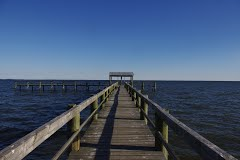
mapcarta.com
In November of 2018, an Anne Arundel County Administrative Hearing Officer granted a variance to allow the demolition and removal of a one-story dwelling and construction of a new dwelling, pool and detached garage on property located entirely within the critical area on Round Bay and Hopkins Creek off the Severn River in Annapolis, Maryland. In addition, the new dwelling would be located within an expanded buffer and the property is surrounded on three sides by steep slopes of 25 percent or greater increasing the potential for erosion after development. CBF, along with neighbors of the property, filed an appeal of this decision on December 7, 2018 as the decision of the Hearing Officer is arbitrary and capricious, and not in accordance with state law or the Anne Arundel County Code. After public hearings were held and all parties submitted their written closing statements, the Board voted 5-1 to deny the variances.
Preserving critical area law is important to the Chesapeake Bay and its tributaries as development within the critical area can have adverse impacts on water quality.
This matter was being handled by CBF Litigation Staff Attorneys Paul Smail and Brittany Wright.
Anne Arundel County Board of Appeals
In the Matter of Snyder Development Corporation and Snyder/Gladstone, LLC.
Case No.: BA 8-16A
Updated: 5/1/19

mapcarta.com
Snyder Development Corporation proposed to build a subdivision, known as Turtle Run, directly on the banks of Deep Cove Creek in Churchton, Maryland. The subdivision was to be located entirely within the Critical Area. On March 2, 2016, the Anne Arundel County Office of Planning & Zoning (OPZ) granted a Conditional Sketch Plan approval for the Turtle Run subdivision. The approval allowed the developer to transfer building density between non-contiguous parcels and concentrate 11 homes on a separate 37-acre parcel located entirely within the Resource Conservation Area (RCA). Among other things, this transfer would have allowed the developer to concentrate density in the RCA and habitat protection areas in violation of the density limitations of the Critical Area Law. The OPZ's approval was contrary to the purpose and intent of Critical Area and county law.
On April 1, 2016, CBF filed an appeal of OPZ's Conditional Sketch Plan with the Anne Arundel County Board of Appeals. A similar appeal was filed by SACReD, West/Rhode Riverkeeper and local property owners. Hearings in this case began on September 7, 2016 and continued through March 1, 2018. Initially the hearings before the Board addressed whether CBF, the local property owners and the other local organizations had legal standing to challenge the sketch plan approval (both the County and Snyder Development argued that they did not). After ten hearings, the Board of Appeals granted standing to CBF, SACReD, the West/Rhode Riverkeeper, and some of the community residents, but denied standing to other nearby residents.
On February 7, 2018, the Critical Area Commission, exercising its statutory authority to protect the Critical Area, voted that Anne Arundel County's program lacks standards that meet the Commission's regulations for the consolidation and reconfiguration of lots in the Critical Area. In addition, the Commission made any approvals of lot consolidations or reconfigurations of nonconforming parcels in the Critical Area null and void until the deficiency is corrected.
As a result of the Commission's order, the Board of Appeals dismissed the Sketch Plan appeal. Thereafter, on May 10, 2018, Snyder Development appealed the decision by filing a Petition for Judicial Review with the Anne Arundel County Circuit Court. However, in a win for the Bay, on August 15th, Snyder Development Corporation sold the proposed development areas (a total of 190 acres) of Deep Cove West and Turtle Run to Anne Arundel County for forest preservation, reforestation, and recreation uses. The sale of the property ensures that the subdivision will not be built and important habitat in the critical area will be protected.
CBF will continue to monitor the improvements to the Anne Arundel County's critical area program to ensure the critical area law is enforced.
This case is being handled by CBF Litigation Attorneys Ariel Solaski, Paul Smail, and former Vice President of Litigation Jon Mueller.
Circuit Court for Anne Arundel County
Margaret McHale v. Board of Appeals of Anne Arundel County, et al.
Case No.: 02-C-14-187171
Updated: 5/30/2015
Maryland's Critical Area Act has a strict prohibition on development within the 200-foot buffer surrounding tidal waters. The Young family sought variances to this prohibition from the Anne Arundel County Administrative Hearing Officer in 2012. The variances were denied. The Youngs appealed that decision to the Anne Arundel County Board of Appeals, which granted the variances on December 11, 2013 because, among other reasons, construction of a home in the buffer would prevent vandalism on the vacant land. This is not a variance criterion and to allow the granting of variances for such reasons would undermine the Critical Area Act. As a result, CBF filed a Petition for Judicial Review with the Circuit Court for Anne Arundel County on January 10, 2014 seeking a reversal of the decision of the County Board of Appeals.
The Critical Area Commission also filed a Petition for Judicial Review of the Board of Appeals decision. CBF's case against the Youngs was consolidated with the Critical Area Commission's actions. Arguments on the Petitions for Judicial Review were held on April 17, 2015.
On May 18, 2015, in an unwritten Opinion, the Circuit Court affirmed the decision of the Anne Arundel County Board of Appeals, allowing the Young's development within the buffer. CBF has decided to not appeal this decision and continue to monitor development in critical area.
These cases are being handled by CBF Litigation Attorney Paul Smail.
Little Island On the Magothy River
Maryland Court of Special Appeals
Margaret McHale et al. v. DCW Dutchship Island LLC et al.
Case No.: 60. September Term, 2013
Updated: 5/1/2015

Scott Cramer
In 2001, local homebuilder Daryl Wagner, operating as DCW Dutchship Island, LLC, tore down a pre-existing cottage and built a large home, swimming pool, and lighthouse on Little Island in the Magothy River. Wagner did not have any of the required building permits, variances, or buffer map amendments needed to carry out his project. Maryland law requires that, in addition to general building permits, citizens apply for and receive variances to construct in any area within 1,000 feet of tidally influenced waters, otherwise known as the Critical Area. Little Island is entirely within the Critical Area. The majority of the island, including the new house, is also within the 200-foot buffer, an area of land in which construction is prohibited without a variance.
After the new construction was discovered by county and state inspectors, Wagner retroactively applied for the necessary variances and modifications to the buffer map. Anne Arundel County Planning and Zoning officials approved the variances and buffer map modifications. CBF appealed those decisions to the Anne Arundel County Board of Appeals.
Hearings were held before the Board over a nine-month period in 2006. The requests for variances and buffer map modifications were addressed separately. Early in the case, the Board erroneously ruled that CBF lacked standing to challenge the variance requests and dismissed us. However, the Board did allow CBF to participate in the buffer map modification part of the hearings.
The majority of the Board followed the lead of the Planning and Zoning officials and voted to grant the variances and buffer map modifications. By January 2007 the Board had issued its written decision which merely adopted the statements of the County's witnesses—including the theory that the island had been "missed" when the buffer maps were created in 1994 and thus, modification of the map to reflect pre-existing "non-functioning" areas of the buffer was appropriate.
CBF appealed the Board's decisions to the Circuit Court for Anne Arundel County. The variance and buffer map modification issues were consolidated into one appeal. Here again, CBF's legal standing was attacked. In the end, the Circuit Court found that CBF had judicial standing to maintain the appeal, but nonetheless upheld the full decision of the Board to grant the variances and allow the house to stand.
This case was eventually appealed all the way to the highest court in Maryland, the Court of Appeals, where the Circuit Court's decision was affirmed and the after-the-fact Critical Area variances were upheld. In the Court of Appeals written opinion, issued on August 14, 2014, the Court upheld all the variances, but remanded the case to the Anne Arundel County Board of Appeals to explain why it granted Wagner a 320-foot impervious boat ramp, something that had not existed prior to Wagner's ownership.
In a one-page opinion, the Board of Appeals simply affirmed its decision to allow the boat ramp finding that the "granting of a variance for the boat ramp is unnecessary, as the boat ramp is a water dependent facility for which a variance is not required."
While the final resolution of the case was not what we sought, the notoriety of this case enabled us to achieve substantial legislative gains: citizens are granted standing to challenge county variance decisions before county Boards of Appeal and in court if they can meet the same standing requirements of federal law whether or not they appeared before the Administrative Hearing Officer or the Board; and a person who constructs within the Critical Area without a proper variance must first tear down the structure before applying for a variance.
This matter was handled by CBF's former Vice President for Litigation Jon Mueller.
Dobbins Island On the Magothy River
Maryland Court of Special Appeals
Chesapeake Bay Foundation et al. v. David Clickner
Case No.: 1926. September Term, 2012
Updated: 5/1/2015
In 2005, David Clickner sought variances to construct a large home on Dobbins Island in the Magothy River and was denied by Anne Arundel County. Late in 2006, Clickner sought variances for a pier, driveway, stormwater controls, and a septic field. CBF objected to the second request on several grounds, including the fact that the pier and stormwater discharge would pass through thriving, but fragile, beds of underwater grasses. Further, the stormwater controls and septic field would be constructed in the Critical Area buffer. The County Administrative Hearing Officer granted the variances for the pier and other additions with some limitations.
In 2007, CBF appealed the decision of the Hearing Officer to the County Board of Appeals. For the next three years, CBF litigated the case—and defended its standing to file the lawsuit—first in Circuit Court and then in the Court of Special Appeals. In April 2010, the Court of Special Appeals sent the case back to the County Board of Appeals for further proceedings.
After several nights of hearings during the summer of 2011 the Board of Appeals decided to grant all of the variances requested. CBF and the Magothy River Association appealed this decision to the Anne Arundel County Circuit Court and then to the Maryland Court of Special Appeals. On February 20, 2014 the Court, in an unpublished opinion, upheld the decision of the Board of Appeals to grant all of the variances.
This matter was handled by CBF's former Vice President for Litigation Jon Mueller.
Moreland
Maryland Court of Special Appeals
Critical Area Commission et al v. Moreland LLC
Updated: 1/28/2011
In 2003, Moreland, LLC, a Maryland company, purchased two lots along Warehouse Creek in Anne Arundel County with the intention of building residential homes. Moreland applied for variances to allow the construction of the two single-family homes with accompanying wells and septic systems within the state designated Critical Area. The Administrative Hearing Officer (AHO) denied this request. Moreland appealed the AHO's decision to the Anne Arundel County Board of Appeals. The Board also denied the variance requests. The South River Federation and local residents participated in the variance hearings before the Board and presented evidence supporting a denial.
In February of 2007, Moreland appealed the Board's denial to the Circuit Court for Anne Arundel County. Based on the legalities of the appeal and the threat to water quality, CBF's Litigation Department agreed to represent South River Federation in this appeal. After hearing written and oral arguments, the Circuit Court ruled in Moreland's favor and overturned the Board's denial. CBF, on behalf of South River Federation, appealed the Circuit Court's decision to the Maryland Court of Special Appeals where the lower court's conclusion was upheld.
CBF appealed this decision to the Maryland Court of Appeals. Finally, on January 28, 2011 the Court reversed the lower courts and affirmed the Board's decisions to deny the variances.
This matter was handled by CBF's former Vice President for Litigation Jon Mueller.
Blackwater Resort Development
Updated: 10/30/2006
The developer of Blackwater Resort Communities planned to build 3,200 single-family and multi-family homes, a 100-room hotel and conference center, a retail center, and a golf course on more than 1,000 acres of forest and farmland along Egypt Road, just south of the City of Cambridge, in Dorchester County, Maryland. This land had been annexed by the City of Cambridge from the County in June 2004. Because much of this project was to be built within Maryland's Critical Area, the developer sought 313 acres of "growth allocation" from both Dorchester County and the City of Cambridge. As part of the Chesapeake Bay Critical Area Act, the Maryland General Assembly limited the amount of acres on which a county could allow construction within the Critical Area.
The Dorchester County Council voted to grant the developer the growth allocation. CBF, along with several local farmers, filed a Petition for Judicial Review of Dorchester County Council's decision in the Circuit Court for Dorchester County. CBF and its farming partners also filed a request for administrative review of this decision before the Dorchester County Board of Appeals. A similar suit and administrative challenge were also filed against the City of Cambridge for its grant of growth allocation to the developer.
Later that year, the City of Cambridge Planning and Zoning Department approved the Design Master Development plan for the project. CBF objected to this decision, as we believed that the changes to the plan were so substantial that they warranted full review. To preserve our objection, CBF filed a petition for review with the Cambridge Board of Appeals. Despite CBF's appeal and City law to the contrary, City Planning and Zoning went forward with approval of the project's Final Master Development Plan. CBF petitioned for review of that decision with the Board of Appeals. The City later approved the Final Master Development Plan. CBF also sought judicial review of this decision in the Circuit Court. All of the administrative appeals were dismissed by the respective Boards of Appeal for lack of jurisdiction (they believed the Circuit Court could only decide these issues). To preserve our claims, we filed appeals of those decisions in the County Circuit Court. Thus, all together, CBF had seven cases pending in Circuit Court. CBF was represented by local attorney Tom Deming.
CBF was also actively involved in opposition to the City's application to the state Critical Area Commission (CAC) for approval of the growth allocation award. We retained two outside consulting firms to evaluate the project and retained five different expert witnesses to provide written and oral testimony to the CAC panel.
On October 4, 2006, the Critical Area Commission (CAC) rendered a first ever decision to deny the award of growth allocation to the City and the developer. The developer and the county filed suit against the CAC. Subsequently, the developer agreed to sell over 700 acres of the site to the State of Maryland. The State also agreed to restore the area from farm fields to buffer areas.
Jon Mueller, then Director of the Litigation Department, participated in the numerous negotiations that led up to the final Memorandum of Understanding signed by the developer and the state. The sale was approved by the General Assembly in 2007. All of the judicial actions were dismissed.
Maryland Habitat and Natural Resources Cases
Maryland Court of Special Appeals
Vieglais v. Dep't of Natural Resources
Case No.: CSA-REG-0080-2017
Updated: 11/1/19
The owners of Beehive Beach Farm, which consists of approximately 28.09 acres of land and is located on Sahlin Farm Road in Annapolis, Maryland, sought a variance to construct a home near steep slopes descending to Hopkins Creek on the Severn River. The Administrative Hearing Officer (“AHO”) denied the variance after a hearing on December 2, 2014 stating that the conditions for granting a variance were not met.
Prior to the AHO decision, the Maryland Department of Natural Resources (“DNR”) disapproved the proposed development of the property, asserting that it violated the terms of the Forest Conservation Easement (“FCE”). The purpose of the FCE is to restrict and limit the use of land and contiguous waters to preserve the state's forests and protect the Chesapeake Bay Critical Area shoreline and aquatic habitat. The FCE prohibits construction of new structures within the Critical Area Buffer. Approximately 19.07 acres of the Vieglais property is located in the critical area and is classified Resource Conservation Area ("RCA").
As a result, the property owners filed a lawsuit against DNR in the Circuit Court for Anne Arundel County on July 31, 2015 alleging breach of contract and requesting injunctive and declaratory relief pertaining to the provisions of the FCE. They claim DNR violated the terms of the FCE, by not allowing them to construct a new dwelling on their waterfront property at the location they desired. They also appealed the AHO decision. However, the administrative appeal was stayed pending the outcome of the suit against DNR.
Conservation easements serve a critical role in preserving riparian forests and other sensitive lands from development in the Chesapeake Bay watershed. CBF filed a Motion to Intervene in the Circuit Court action on December 11, 2015, as an interested person on the side of DNR to ensure enforcement and interpretation of the FCE and on March 15th CBF's Motion to Intervene was granted. After Discovery was completed, DNR, CBF and fellow co-intervenors (James and Sylvia Earl, Sherwood Forest Company and Sherwood Forest Club, Inc.) filed Motions for Summary Judgement asserting that Defendants are entitled to Judgment in their favor as a matter of law. Plaintiffs also filed a Motion for Summary Judgement. A Complex Motions Hearing was held on December 19, 2016 and on January 26th, Judge Goetzke Ordered summary judgment as to liability and damages in favor of DNR and the Intervenors against the Plaintiffs under Count 1 of the Complaint (Breach of Contract). However, the Judge denied judgment under Counts II through V (Declaratory Relief). Plaintiff's Motion for Summary Judgment was also denied. Trial was held the week of February 6, 2017. At the conclusion of trial, Judgment was granted in favor of DNR and the Intervenor Defendants.
On March 30, 2017, Plaintiff's noted an Appeal to the Maryland Court of Special Appeals based on the following Issues:
- Whether the Circuit Court erred in granting Motion to Intervene as to James and Sylvia Earl, The Sherwood Forest Club and Chesapeake Bay Foundation.
- Whether the Circuit Court erred in granting Summary Judgment as to liability and damages in favor of the Defendant and Intervening Defendants.
- Whether the Circuit Court erred in granting Motion for Judgment in favor of Defendants and Intervening Defendants.
- Whether the Circuit Court erred in its Declaratory Judgment in favor of Defendants and Intervening Defendants.
Oral Arguments were held in April 2018 in front of a three-judge panel in the Maryland Court of Special Appeals located in Annapolis, Maryland. On August 30, 2019, the Court affirmed the trial court's ruling that the Forest Conservation Easement prohibits the redevelopment and relocation of the waterfront home site proposed by the property owners, as well as the expansion or relocation of the existing structure. This is an important win for the Chesapeake Bay and its tributaries because protecting Maryland's forests, especially within the Maryland Critical Area, is necessary to maintain shoreline health, wildlife habitat, and water quality.
This case was being handled by CBF Litigation Attorney Paul Smail.
Maryland Court of Special Appeals
Chesapeake Bay Foundation, Inc., et. al. v. K. Hovnanian's Four Seasons at Kent Island, LLC, et. al.
Case No.: September Term, 2016 No. 1705
Updated: 12/1/17
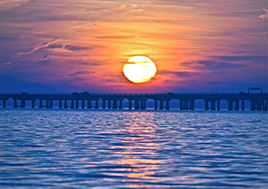
Michael Adams
The Maryland Board of Public Works voted 2-1 on November 18, 2015 to approve a Tidal Wetlands License for K. Hovnanian to build an active adult community known as Four Seasons on approximately 556 acres of land on Kent Island in Queen Anne's County, Maryland. The license authorizes K. Hovnanian to 1) drill a sewer line beneath the State wetlands of Cox Creek; 2) construct a community pier extending into Chester River; and, 3) discharge fill from the development project's stormwater management system into Cox Creek and the Chester River.
CBF, along with our co-petitioners Queen Anne's Conservation Association, Midshore Riverkeeper Conservancy, Chester River Association, and neighbors Robert Foley and Hal Fisher filed a Petition for Judicial Review of the Board's decision with the Queen Anne's County Circuit Court on December 18, 2015.
This matter has been ongoing for some time. K. Hovnanian applied for a Tidal Wetlands License in 1999 and was initially denied on Mar 23, 2007. K. Hovnanian appealed this decision to the Maryland Court of Appeals and the case was remanded back to the Board of Public Works for further consideration. K. Hovnanian submitted a modified proposal to the Board in May, 2013. However, MDE did not provide for public hearings or allow public comments on the revised License application regarding the current stormwater management system. As a result, the Board should not have voted to approve the License. CBF is committed to restoring water quality in the Chesapeake Bay and preserving the conservation of wetlands from polluted stormwater runoff.
A Hearing in this matter was held on June 28, 2016 and on September 20th, Judge John W. Sause, Jr., issued a Memorandum Affirming the decision made by the Board of Public Works approving the Tidal Wetlands License. CBF and our co-petitioners filed an Appeal of this decision to the Maryland Court of Special Appeals on October 20, 2016. Briefing is completed and Oral Arguments were held on October 12, 2017.
On November 22, 2017, in an unreported opinion, the Court of Special Appeals affirmed the Judgment of the Circuit Court for Queen Anne's County approving the tidal wetlands license issued by the Board of Public Works. CBF continues to monitor the development on Kent Island.
This case was being handled by CBF Litigation Attorney Paul Smail.
Natural Gas Pipelines
Mountain Valley Pipeline
United States Court of Appeals for the 4th Circuit
Mountain Valley Pipeline, LLC v. State Air Pollution Control Board
Case No.: 22-1000
Updated: 3/29/2022
The Mountain Valley Pipeline (“MVP”) project, originally proposed in 2014, is a 304-mile natural gas pipeline extending from southern Virginia to northwestern West Virginia that will cut across the Jefferson National Forest in Virginia and the Appalachian Trail in West Virginia. Construction and operation of the pipeline will have negative impacts to forests, waterways, wildlife, air quality, and communities along the path.
In September 2020 MVP submitted an application to construct and operate a natural gas compressor station to support an extension of the pipeline, known as the Lambert Compressor Station, in Chatham, VA. The compressor station would consist of two natural gas fired turbines within the Chesapeake Bay airshed that would emit fine particulate matter (PM2.5) and other pollutants as part of its operation in an environmental justice community. CBF and our partners submitted comments detailing the public health concerns from PM2.5 emissions and the health risks to specific affected communities. On December 3, 2021, the Virginia State Air Pollution Control Board denied MVP’s minor new source review permit for the compressor station finding that the proposed permit does not meet the definition of “fair treatment” as defined by the Virginia Environmental Justice Act and the environmental justice standards set forth by the court in Friends of Buckingham v. State Air Pollution Control Board.
MVP filed an appeal of the state air board’s decision with the U.S Court of Appeals for the Fourth Circuit. CBF, on behalf of its members, Elizabeth and Anderson Jones, whose family farmland lies near the proposed compressor station, filed a Motion to Intervene to defend the Air Board decision to deny the permit. Also, moving to intervene in the case are the Southern Environmental Law Center, on behalf of the Virginia State Conference NAACP. CBF’s Motion to Intervene was granted on February 2, 2022. Prior to briefing and arguments, MVP filed a Motion for Voluntary Dismissal on March 29, 2022. We continue to monitor the pipeline project for updates.
This matter was being handled by CBF’s Environmental Justice Staff Attorney Taylor Lilley and Litigation Attorney Ariel Solaski.
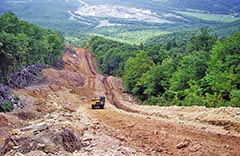
Wide swaths of land cleared for laying pipeline destroy critical forests and create extensive sediment runoff.
The Bay Journal
Dominion Atlantic Coast Pipeline
On July 5, 2020, Dominion Energy and Duke Energy, the developers of the Atlantic Coast Pipeline, announced they were abandoning the project designed to carry natural gas 600 miles through West Virginia, Virginia, and North Carolina. CBF was one of many advocates and litigants fighting to stop the pipeline due to the unprecedented risk the pipeline would present to people, waterbodies and forests in Virginia. Our victory in the Fourth Circuit Court of Appeals revoking an air pollution permit that would have allowed the construction of a gas burning compressor station in a Buckingham County minority community was one of the factors contributing to the demise of the project. CBF’s Statement on Cancellation of Atlantic Coast Pipeline
As required by the Federal Energy Regulatory Commission (“FERC”), Dominion submitted a Restoration Plan on December 16, 2020. The plan outlines the steps Dominion will take to restore the areas where construction had begun. CBF continues to monitor the FERC proceedings and will take appropriate action, if necessary, to ensure adequate restoration projects are completed including areas where trees have been removed, farm fields have been paved for staging yards, waterbodies where pipes have been installed, and where endangered species habitat has been destroyed.
Background Details
The Atlantic Coast Pipeline ("ACP") is an expansive operation spanning the distance of more than 600 miles from the Allegheny Mountains through North Carolina, including streams, rivers and wetlands in the Chesapeake Bay watershed throughout Virginia. More than 21 miles of line will cross national forest lands in Virginia and West Virginia. In addition, the proposed pipeline would have generated additional sediment and nutrients, resulting in an unprecedent risk to these waterbodies, as well as wetlands and forests in the Chesapeake Bay watershed. Forests are vital to the health of the Bay as they prevent pollution from entering waterways, protect clean air, and provide habitat to wildlife throughout the region. Thousands of acres of forests will be destroyed to construct the pipeline.
Legal Challenges
Challenge to Certificate of Public Convenience and Necessity
United States Court of Appeals for the District of Columbia Circuit
Atlantic Coast Pipeline, et. al. v. Federal Energy Regulatory Commission
Case No.: 18-1224
In October 2014, Atlantic and Dominion were granted approval for pre-filing review of the proposed Atlantic Coast Pipeline project by the Federal Energy Regulatory Commission ("FERC"). FERC reviews applications for construction and operation of interstate natural gas pipelines under Section 7 of the Natural Gas Act. In February 2015, FERC published a Notice of Intent to prepare an Environmental Impact Statement (EIS) and requested public comments. CBF along with other organizations filed comments and motions to intervene to protest the proposed pipeline project. In September of 2015, Atlantic and Dominion filed applications with FERC for certificates of public convenience and necessity. This certificate is required for the construction or expansion of natural gas facilities used for the sale or transportation of natural gas and must be issued by FERC, along with the EIS.
Despite the significant environmental impacts associated with the proposed pipeline, FERC issued the final EIS on July 21, 2017 and issued an Order granting the certificate of public convenience and necessity on October 13, 2017 without considering relevant evidence in the record.
On November 13, 2017, CBF and our partners filed a Petition with FERC requesting a rehearing and a stay of the Certificate’s Order, which would pause pipeline construction while the review was being completed. However, rather than ruling on the rehearing request, FERC indefinitely postponed a ruling without issuing a stay while construction of the pipeline was underway. This allowed construction to proceed even though a request for reconsideration was pending. As a result, in March of 2018, CBF and our partners filed a Petition with the Fourth Circuit Court of Appeals asking the Court to stay construction of the Pipeline until FERC issued a final Order on the November 13th rehearing request. The 4th Circuit Dismissed the Petition for lack of jurisdiction and in August of 2018 FERC denied our rehearing request.
After FERC denied the rehearing request, CBF and our NGO partners filed a Petition for Review with the U.S. Court of Appeals for the 4th Circuit requesting the Certificates Order be vacated. Our case was transferred to the D.C. Circuit Court of Appeals and consolidated with an appeal filed by ACP related to FERC’s Certificates Order on construction funding. Briefing was completed and the oral arguments scheduled for October 16, 2019 were removed from the court docket and the case held in abeyance until the United States Supreme Court ruled on a separate matter regarding the Atlantic Coast Pipeline and a special use permit authorizing the construction of the pipeline through parts of the Appalachian Trail and George Washington and Monongahela National Forests, Atlantic Coast Pipeline, et. al. v. Cowpasture River Preservation Association. In June of 2020, the Supreme Court ruled in favor of ACP in this case overturning the 4th Circuit decision vacating the permit issued by the U.S. Forest Service.
On July 23, 2021, FERC made available for public comment a draft Supplemental Environmental Impact Statement for the proposed restoration project. On September 13, CBF joined our NGO partners and filed comments on this restoration plan urging FERC to make revisions and address shortcoming, including how tree removal will occur around wetlands and waterbodies. This case was voluntarily dismissed on November 18, 2022 as the restoration activities for the pipeline have been approved by FERC.
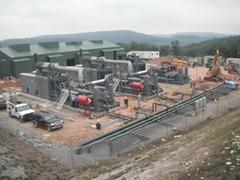
The Buckingham Compressor Station
Friends of Buckingham
Buckingham County Compressor Station
United States Court of Appeals for the Fourth Circuit
Friends of Buckingham, et. al. v. State Air Pollution Control Board, et. al.
Case No.: 19-1152
Dominion applied for a permit to construct and operate a natural gas compressor station in Buckingham County, VA for the Atlantic Coast Pipeline. The permit would allow the new source to emit greenhouse gases, nitrogen oxides, and other toxic pollutants into the atmosphere, harming air quality and public health in violation of the Virginia State Constitution. In addition, the community where the compressor station would be built is a historic African American community raising environmental justice issues. CBF submitted comments on the proposed permit and testified at the hearing before the Virginia Air Pollution Control Board on November 8, 2018. After allowing for additional public comments related to demographics and site suitability, the Board voted 4-0 to approve the air permit on January 8th. Issuance of the permit violates the state clean air law because the board improperly considered a state statute requiring the board to determine the suitability of the site for the compressor station given that is being placed in a minority community.
As a result, on February 8th, CBF and SELC (representing Friends of Buckingham) filed a Joint Petition for Review with the 4th Circuit Court of Appeals. Oral arguments were held on October 29, 2019. On January 7, 2020, the 4th Circuit issued a Published Opinion vacating the Permit and remanding the case back to the Virginia Air Pollution Control Board. The Court held that the Board did not perform its statutory duty to determine whether the facility is suitable for this site, in light of environmental justice and potential health risks for the people of Union Hill.
CBF was represented in these cases by the former Vice President for Litigation Jon Mueller, staff counsel in the Virginia office, and counsel for the Southern Environmental Law Center.
Water Quality Certification
United States Court of Appeals for the Fourth Circuit
Chesapeake Bay Foundation, et al. v. State Water Control Board, et. al.
Case No.: 18-1077
The Virginia Department of Environmental Quality is responsible for ensuring that the proposed project complies with all state water quality standards, including obtaining a section 401 water quality certification as defined in Section 401 of the Clean Water Act, 33 U.S.C. § 1341(a). Section 401 certification process requires states to assess whether a federal-permitted project, that discharges into the states navigable water, violates the state's water quality standards.
The Commonwealth of Virginia's Department of Environmental Quality ("DEQ") and the Virginia State Water Control Board issued the 401 Water Quality Certification to ACP on December 20, 2017. CBF along with local co-plaintiffs filed a Petition for Review of this decision with the United States Court of Appeals for the Fourth Circuit located in Richmond, VA on January 19, 2018. CBF and our co-plaintiffs allege that DEQ and the Water Control Board lacked sufficient information to find "reasonable assurance" that the proposed ACP would not violate state water quality standards, as required by Section 401 of the Clean Water Act. In addition, the certification was issued without providing adequate public notice and comment opportunities throughout the certification process.
CBF's case was consolidated with an appeal filed by Southern Environmental Law Center ("SELC") representing several organizations, including Appalachian Voices, Sierra Club, and Chesapeake Climate Action Network. Arguments were held on September 28, 2018 in the 4th Circuit Court of Appeals located in Richmond, Virginia and on January 14th, in a published opinion, the Court denied the joint petition for review and upheld the water quality certification issued for the Atlantic Coast Pipeline.
Virginia Natural Gas Header Improvement Project
Virginia State Corporation Commission
Updated: 12/2/2020
Virginia Natural Gas (VNG) filed an application with the Virginia State Corporation Commission (SCC) for a Certificate of Need for the construction of 24 miles of pipeline to provide gas to a new gas-fired electric generating station owned by Dominion in Charles City, Virginia, and additional projects, collectively known as the Header Improvement Project. The project consists of six individual projects, three pipeline segment construction projects, two compressor station construction projects, and one compressor station expansion project. More than 153 acres of wetlands and 313 acres of trees will be disturbed for the construction of the pipeline. The project would affect communities in Prince William, Fauquier, Caroline, Hanover, Henrico, New Kent, and Charles City counties. Dozens of homes appear to lie within 500 feet of the 24 miles of proposed pipelines.
Residents near the proposed pipeline and compressor stations will be at risk of increased levels of greenhouse gases and other toxic pollutants. In addition, many of the communities surrounding the project are minority communities and communities of color raising environmental justice issues.
On March 3, 2020, CBFand other groups challenged VNG’s application. CBF participated in Discovery and provided testimony during the evidentiary hearing held on May 13th. On June 26th, the SCC issued its preliminary order conditionally denying VNG's application. The Commission ordered VNG to establish all necessary financing and undertake an environmental justice analysis by December 21, 2020. On December 1st, the SCC dismissed VNG's application for a Certificate of Public Convenience and Necessity. VNG must file a completely new application if it wishes to proceed.
CBF will continue to monitor any developments related to this project.
This matter is being handled by CBF Environmental Justice Staff Attorney Taylor Lilley.
Marcellus Shale Projects
Updated: 8/5/2013
STATE LEVEL (Pennsylvania)
On April 1, 2009, Pennsylvania's Department of Environmental Protection (DEP) eliminated the role of local conservation districts in the review process of Erosion & Sediment Control plans and permits and Stream and Wetlands Encroachment permits for the natural gas industry. Conservation districts are traditionally experts in erosion control and stream protection and their expertise in this area is invaluable to the protection of the environment.
Late that summer, and in response to permits issued to several natural gas companies under the new expedited permitting process, CBF filed three appeals with the Pennsylvania Environmental Hearing Board (EHB) challenging erosion and sediment control permits issued to Ultra Resources Inc. and Fortuna Energy Inc. As a result of the legal challenges, DEP revoked the three erosion and sediment control general permits. One of the companies, however, filed a separate appeal of the decision to revoke its permit.
In July of 2011, CBF and DEP reached an agreement that resolved all of the questions presented in the appeals. The formal settlement agreement, approved by the EHB, requires DEP to amend its permit review process to prohibit an expedited review for applicants seeking a permit for projects located in, or with the potential to discharge to, waters that have been designated as high quality or exceptional value; and for projects in which the well pad will be constructed in or on a floodplain.
To ensure compliance with the agreement, CBF, with the assistance of an outside contractor, continued to monitor the natural gas well pad construction in Exceptional Value and High Quality watersheds in Pennsylvania.
FEDERAL LEVEL
On April 4, 2011, CBF and other groups filed a formal citizen petition with the federal government requesting the completion of a programmatic environmental impact statement (PEIS) to assess the cumulative impacts of drilling in the Marcellus Shale formation on the Chesapeake Bay watershed, and the promulgation of necessary regulations based upon the outcome of the study. The petition was filed with the Council on Environmental Quality (CEQ) requesting it to provide the necessary oversight and guidance to all federal agencies involved in the regulation of natural gas development. No formal response from CEQ has been provided.
In February of 2012, CBF filed an amicus curiae brief in Brooklyn federal court in support of New York State's position that federal coordination is required under the National Environmental Policy Act (NEPA) for the Delaware River Basin Commission's authorization of unconventional natural gas development in counties that are located within the Delaware River Basin and the Chesapeake Bay watershed. While the Court noted that CBF's amicus brief was informative, it dismissed the case for lack of subject matter jurisdiction in September of 2012.
These matters were jointly handled by CBF's Litigation Department and Pennsylvania Office, along with assistance from law students at Drexel University School of Law.


